

Worst Case Scenario (episode)
- 1.2 Act One
- 1.3 Act Two
- 1.4 Act Three
- 1.5 Act Four
- 1.6 Act Five
- 2 Log entries
- 3 Memorable quotes
- 4.1 Title, story, and script
- 4.2 Cast and characters
- 4.3 Production
- 4.4 Reception
- 4.5 Continuity and trivia
- 4.6 Apocrypha
- 4.7 Video and DVD releases
- 5.1 Starring
- 5.2 Also starring
- 5.3 Guest star
- 5.4 Co-star
- 5.5 Uncredited co-stars
- 5.6 References
- 5.7 External links
Summary [ ]
B'Elanna Torres looks apprehensive as she walks down the corridor on the ship and approaches the turbolift to report for duty , and even more so as Chakotay joins her casually. Once they are in the turbolift, Chakotay begins asking a series of strange questions pertaining to his dislike for Tuvok and mentions that in fact a lot of the crew are not happy with the chief of security and Captain Janeway for that matter. He wonders whether Torres agrees, stating that there will be some changes around here. It seems a mutiny is in the works. All of the Maquis and 25 of the Starfleet crewmembers are behind him, and he wants to know which side Torres is on once the shooting starts.
Act One [ ]
On the bridge , Torres and the other officers go about their duties, pushing buttons as if they are doing something, when Captain Janeway announces she will be going off in a shuttlecraft with Tom Paris and leaving Chakotay in command of the ship . Chakotay tries to convince the Captain to bring Tuvok with her, without success. The first officer has Harry Kim perform a diagnostic that shuts the transporters down before a pair of security personnel arrive with what Chakotay claims to be the duty roster . As soon as Janeway's shuttle goes to warp , Chakotay tells all hands to begin their plan and commences the takeover, stunning Tuvok and Kim before moving on to the rest of the ship. Torres goes along with his plan. Then there is a surprise: they turn a corner to find Seska .
The siege continues through the mess hall – where Neelix takes their side. With the senior officers in the brig and the rest of the loyal Starfleet personnel held prisoners in an empty cargo bay , Chakotay announces his plan of dropping the senior staff off at the nearest habitable planet and taking USS Voyager straight home – this time without letting mighty "Starfleet principles" get in the way. He offers the remaining crew the chance to join him, when suddenly Paris enters the cargo bay and asks Torres what's going on. It is then revealed that this has all been a holo-program depicting a Maquis mutiny. Torres tells Paris that she was doing a routine purge of the database to get rid of old files when she came across this holonovel, telling Paris that it is a very compelling story. Paris asks who wrote it, and Torres admits she doesn't know as the author has encrypted the program to protect his or her identity, presumably due to the controversial plot.
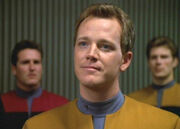
Tom Paris in gold uniform
Act Two [ ]
Torres and Paris discuss reporting the program to Captain Janeway, but decide it best if they get a "full report", so Paris has a go with the program. During Paris' run, he walks down the corridor wearing an operations division gold uniform . Chakotay approaches Paris the same way he approached Torres, and knowing what will happen, Paris eagerly goes along with the plan. When it is time for Chakotay's mutiny, Paris attempts to warn Tuvok, but it is too late; once again, Tuvok and Kim are shot, but this time Paris joins them and the other loyal Starfleet officers in the brig. There, Paris grows impatient with simply "waiting around", but Tuvok insists that they wait for an opportunity to overpower the enemy. Chakotay eventually comes along to take everyone but Tuvok and Kim to cargo bay one. There he gives the same speech as before, when Torres ran the holonovel, which inspires Paris to join him.
Paris and Torres now discuss the holonovel eagerly in the mess hall, and Paris reveals that his constant switching loyalties has apparently caused Chakotay to assign him to menial tasks. Torres advises him to go along with the mutiny from the start, since that is a lot more fun to play out. As they talk about plans of attack, Neelix wanders by and reveals that he too has played the program, and describes his own strategy; he tried to send a secret message to Janeway's shuttle , but was caught by Chakotay. It seems Torres told The Doctor , who told Neelix, who promises his lips are sealed; but as he speaks, Kim shows up asking them about the holonovel Ayala told him about.
Paris and the mutineers are on the bridge again, out of uniform and in control despite problems with the warp core likely the result of a saboteur . As Janeway and the holographic Paris return in their shuttle, she has a chilly reunion with Chakotay, who genuinely does not want to hurt anyone. However, she attacks Voyager head-on and beams aboard with Paris as it opens fire to destroy her shuttle. Chakotay and Paris take the turbolift to the brig, where Janeway and her former first officer shoot one another before Paris comes face-to-face with himself. Paris and his holographic counterpart have each other at phaser point...
...when suddenly the program shuts down leaving only an empty holodeck. Paris tries to resume the program but fails, as the computer explains no more story has been written so cannot continue. Paris is left very frustrated at the lack of conclusion.
Act Three [ ]
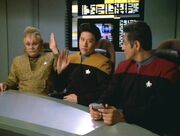
" I've been running it too. " " Anybody else? "
In the holodeck, Torres and Paris try to access information on the author of the holonovel from the computer. Despite Torres' knowledge of computers and Neelix's gift of gab, no one is able to find the mysterious author of the holonovel. Janeway brings it up at the next staff meeting, by which time the program has been accessed 47 times by 33 different crew members. Of course, everyone present has tried it (save Janeway and Chakotay), but no one knows who made it, so she tells them to talk to their respective staff and find the author. However, Tuvok reveals that in fact it was he himself who wrote the program, albeit not as a novel but more as a tactical training exercise for his security personnel in the event of a mutiny. He explains that he wrote the program when the Maquis crew had just joined the Voyager crew and when the possibility of a mutiny was very real. But when the two crews began to successfully work together, he realized that the threat of an insurrection was increasingly unlikely and the program might have ended up inciting ill feeling between the crews and and therefore deleted it – until Torres recovered the file. Paris asks if Tuvok intends to continue, but Tuvok instead wishes to permanently delete it since he still feels it could cause discontent between the Starfleet and Maquis crews and expects Janeway to agree. However, contrary to his expectations, Janeway tells him to 'loosen up'. She tells him that while he may have intended it to be for tactical training it has clearly become some harmless fun, and stresses the need for original sources of entertainment now that they are so far away from home . Even Chakotay jokingly speculates that finding an ending to the novel is necessary because, if Tuvok doesn't write one, the crew will really mutiny to find it out by itself. Paris then volunteers to write an ending, and Janeway jokes that she is excited to see how her character will manage to outwit the mutineers.
Tuvok finds Paris in the mess hall, working diligently on an ending for the novel. When he suggests helping him craft the novel with some level of organization and logical application, Paris casually states that he doesn't need any help in that regard as he is sort of making it up as he goes along. He tells Tuvok that in his version, Paris and Janeway retake the ship and Janeway decides to execute all the conspirators. Tuvok objects that this is a completely implausible plot development, since Captain Janeway would never do something so inhumane. But Paris laughs his objections off, saying that this isn't real life but just fiction. Tuvok reiterates the importance of applying logic when writing stories and characters, citing the Vulcan Dictates of Poetics , which state that a character's actions must flow, inexorably, from his or her established traits. But again, Paris laughs off Tuvok's insistence on logical application and in fact finds his own interpretation of things more fun. The two continue butting heads over the Dictates of Poetics versus pure fun until Torres and Neelix each drop by to offer suggestions. Much to Tuvok's annoyance and objections that this isn't a romance novel , Torres wants to see some passion and heart in the story. Paris suggests adding a passionate scene between "the Starfleet conn officer and the Maquis engineer." Neelix, on the other hand – while not making any plot suggestions – tells Tuvok that he was completely misportrayed as he would would never betray Captain Janeway like the holographic Neelix did. Paris jokes that Tuvok must have forgotten to follow the Dictates of Poetics , at which point Tuvok suggests that it might be best to move their work to some place more quiet.
The two go to the holodeck , where they find The Doctor waiting with his own set of suggestions. Once Tuvok gets rid of The Doctor, Paris tries to get rid of Tuvok… only for Tuvok to reveal he is the only person who can make alterations to the program. Paris concedes defeat and agrees to let Tuvok finish the program with him. Tuvok prepares the holonovel for additions and has the holodeck open the narrative parameters file of the program. Suddenly, the hologrid begins to glitch while the transporters on Voyager shut down, the comm system goes off-line, and the holodeck controls become scrambled. The holodeck safety protocols are also disengaged. Tuvok and Paris suddenly appear in the brig, face-to-face with none other than Seska. It seems the Cardassian spy found Tuvok's program some time ago and rewrote it so the ending will be not-so-happy for its participants. Seska tells a confused Tuvok and Paris that they have ten seconds to run for their lives or she will shoot them with a phaser.
Act Four [ ]
Tuvok tries to disable the holodeck program and contact help, but to no avail. Seeing no other alternative, Tuvok and Paris run from the brig where they encounter Captain Janeway, whom they almost immediately recognize as being holographic. "Janeway" asks them to help her retake the ship by transporting into the cargo bay. Tuvok thinks that they shouldn't participate in the scenario, as it presents the least possible risk. After all, Seska may have programmed the holographic Janeway to betray them. Janeway configures the transporter and tells Tuvok and Paris to go when Chakotay and Seska appear at the door. Janeway defends herself with a phaser rifle, but it malfunctions and she is killed. Seska then tells Tuvok and Paris to run. Paris tells Seska that none of the simulation is real, including the holographic Chakotay who is attracted to her. She gets angry and has Chakotay shoot Paris' arm with a phaser, removing any doubt that safety protocols on the holodeck had been disabled. Tuvok and Paris run once again. They enter sickbay to try to treat Paris' phaser wounds. The Doctor appears and says he's going to treat Paris' second-degree phaser burns, but he uses a hypospray to inject twenty ccs of nitric acid into his arm. Tuvok tries to help Paris, but The Doctor grabs him and starts to choke him. The Doctor's arms are the only part of him that are solid, so any attempts to hurt The Doctor are unsuccessful. Once The Doctor is finished "treating" them, he throws Tuvok and Paris out.
On the bridge, the real Captain Janeway asks for information on Seska's modifications to the holodeck program. It turns out that on stardate 48671, a month before she left Voyager , Seska found the program and modified it. She triggered her modifications to activate when Tuvok re-opened the narrative parameters file. To make matters worse, Seska put in various booby trap subroutines to prevent the crew from helping Tuvok and keeping him trapped on the holodeck. For example, if the holodeck doors are forced open, the holodeck will explode. Janeway gets an idea to help… perhaps she could modify the program by co-writing it in a manner that would ultimately help Tuvok and Paris.
Inside the holodeck, Tuvok and Paris are traveling through a Jefferies tube where they encounter a plasma fire behind a door. Tuvok isn't able to close the door, but all of a sudden a plasma extinguisher appears. Paris extinguishes the fire and crawls down to the next deck. Tuvok and Paris realize they are being helped from the outside; however, Janeway is only able to make minor changes. A display appears telling them to go to the weapon's locker for additional help. When they reach the locker, however, Chakotay and a group of Maquis appear, and Paris and Tuvok are captured. Janeway, outside the holodeck, learns that Seska had programmed the holodeck to adapt to any changes that were made to it.
Act Five [ ]
In engineering, Janeway and Torres are re-writing the program to help Paris and Tuvok. Harry Kim reports that the altered program has burned out the transporter access relays, so they can't simply beam them out of the holodeck for the time being. Meanwhile, in the holographic cargo bay, Seska tries to have Tuvok and Paris killed, but Janeway alters the Chakotay hologram character to prevent him from cold-bloodedly murdering the two. Angrily, Seska kills Chakotay to prevent any interference in her plans. Undeterred, Janeway decides another way to modify the program: she rewrites it to include a Rukani attack. Tuvok and Paris are able to take the weapons from the crew during the attack. Seska refuses to give up and activates a sixty-second auto-destruct , which would destroy the holodeck and everyone on it in the process. Tuvok tells Seska that he set his phaser rifle to kill and he will fire if she does not disable the auto-destruct. Seska refuses and demands that he hand over the phaser rifle to her. Tuvok does so, and Seska deactivates the self-destruct. She then turns the phaser rifle on Tuvok and Paris, intent on killing them. However, the weapon malfunctions, killing Seska. Tuvok reveals that he had reconfigured the rifle to malfunction in the same way it had for the holographic Janeway in the transporter room . With the holographic Seska dead, the story has come to an end and the simulation finally shuts down. Kim reports that the transporters have been brought back online, but Janeway assures him that there is no rush.
The senior staff is having a discussion in the mess hall about holo-novels. Chakotay says that he looks forward to the next one, just as long as in whatever they write next, he is not the bad guy. Neelix suggests a story about a cook on a starship, similar to his own life. Tuvok says that if they decide to collaborate on a new holo-novel, they will choose a subject much less close to home.
Log entries [ ]
- Personal log, Tom Paris
Memorable quotes [ ]
" Under my command, we won't let almighty Federation principles get in the way of opportunities the way Janeway did when she destroyed the array that could have gotten us home. And we won't be wasting precious time stopping to investigate every insignificant anomaly that we come across. What we will do is use any means necessary to acquire technology that can shorten our journey. To hell with Starfleet regulations. You have fifteen minutes to make up your minds. "
" Remember the good old days when it was impossible to keep a secret on a ship this small? "
" You never should have crossed her, Tuvok. " " SHE has been dead for over a year! There was no way to predict this turn of events. " " I guess we should have known Seska wouldn't let a little thing like death stop her from getting even. "
" I don't care what kind of story it is, as long as I'm not the bad guy this time. "
" Now up until now the story has been nothing but action, which is fine, but what it needs is a little heart, a little emotion. " " We are not writing a romance novel, Lieutenant. "
" No offense Mr. Vulcan, but I don't think you understand my character very well. " " Tuvok, did you forget to follow the Dictates of Poetics ? "
" Twenty ccs nitric acid – a little proverbial salt in the wound. "
" Mr. Neelix, if Mr. Paris and I do create another work of holofiction, I assure you, we will choose a subject much less close to home. "
Background information [ ]
Title, story, and script [ ].
- In Germany, this episode's title (translated back into English) is "Rebellion Alpha", after the holo-program (which is called " Insurrection Alpha " in the English version of the episode).
- This episode had the working title "Novelty". [1] (X)
- While writing this episode, co-producer Kenneth Biller attempted to add a certain comedic flavor to the installment. He said of the episode, " I won't say it's an out-and-out comedy. It ultimately has some serious jeopardy to a couple of the characters, but it's a comic musing on the creative process. It operates on a lot of different levels. It's a little inside stuff about the creation of the show, the process of writing for Star Trek , and the interaction between the actors who we write for, and the writing staff. It was a lot of fun to write. " ( Cinefantastique , Vol. 29, No. 6/7, p. 113)
- The episode's final draft script was submitted on 14 February 1997 . [2] (X)
Cast and characters [ ]
- Actress Martha Hackett appreciated the reappearance of her role of Seska in this episode, that character having recurred in Star Trek: Voyager 's first two seasons. Hackett said of this episode, " Even when I had been off the show for a season and, you know, we pretty much thought Seska had disappeared, there she was. She came back to haunt them – in a very clever way, I thought – when they brought [her] back as a hologram. And […] you know, it was kind of fun to go back to that, [to] bring all those storylines back up again. " ( VOY Season 3 DVD special features) Hackett also commented, " I thought it was great that she thought ahead and planned something that would mess with people even after she wasn't around. " [3]
- Not only did Martha Hackett like the way in which this episode brought back the character of Seska, but the actress also enjoyed appearing in the installment. " I was really pleased when they invited me back. I thought it would be great fun, " she remembered. " It was really nice to go back and the cast were all very welcoming. Also, it was enough time after I'd had my baby, so I felt myself again and was more free to work. I had worked just after I had my son, but a bit too soon afterwards, and it was a little stressful. This episode was good timing. " ( Star Trek Monthly issue 34 , p. 40)
- Janeway actress Kate Mulgrew counted this as one of her eight favorite installments of Star Trek: Voyager 's third season. ( The Official Star Trek: Voyager Magazine issue 14 , p. 32)
- The episode was also pleasant for Paris actor Robert Duncan McNeill , who said that he " really enjoyed the episode with Tuvok, 'Worst Case Scenario', " and related that the reason he found this episode to be " a lot of fun " (in common with the two-parter " Future's End " and " Future's End, Part II ") was due to " a comic side that comes out of both of us [ meaning himself and Tuvok actor Tim Russ ] when we share the screen." ( Star Trek Monthly issue 37 , p. 44)
- Jennifer Lien ( Kes ) appears in this episode only as a hologram, with the same hairstyle she sports for most of the first three seasons.
Production [ ]
- During the making of this episode, at least two flubs were made. One was while filming the scene wherein the real Paris notifies Chakotay that Holo-Paris and Janeway are returning to the ship. After Paris actor Robert Duncan McNeill gave Chakotay actor Robert Beltran this news, Beltran paused and then, breaking character, asked McNeill, " How do you know? " to which the cast and crew erupted into laughter. The other was during filming of the scene in which Tuvok is shot by Chakotay; Tuvok actor Tim Russ dramatically over-performed his reaction to being shot. These outtakes were included in the UPN special Ultimate Trek: Star Trek's Greatest Moments .
Reception [ ]
- Ken Biller was ultimately delighted with his script for this episode. He noted, " This is maybe my favorite script of all time. " Biller also liked, in this episode, the performances of some members of Voyager 's main cast. He remarked, " I think [it] really shows off some of the actors in our cast who are very strong with comedy. " ( Cinefantastique , Vol. 29, No. 6/7, p. 113)
- This episode achieved a Nielsen rating of 4.0 million homes, and a 6% share. It was the least watched installment of Star Trek: Voyager 's third season (on first airing). [4] (X)
- Nevertheless, Martha Hackett believed that the reappearance of Seska in this episode had fan support. The actress noted about the fact that Seska is brought back as a hologram, " That's something the fans appreciated. " ( VOY Season 3 DVD special features)
- Cinefantastique rated this episode 3 and a half out of 4 stars. ( Cinefantastique , Vol. 29, No. 6/7, p. 113)
- Star Trek Magazine scored this episode 3 out of 5 stars, defined as "Warp Speed". ( Star Trek Monthly issue 32 , p. 93)
- The unauthorized reference book Delta Quadrant (p. 187) gives this installment a rating of 8 out of 10.
Continuity and trivia [ ]
- This episode represents a follow-up to the tension between the Maquis and Starfleet crews that was apparent through many episodes of the first season, notably " Parallax ", " State of Flux " and " Learning Curve ". Although Tuvok does not reveal exactly when he wrote the holonovel, it is likely to have been before " State of Flux ", in which Seska is revealed to be Cardassian and leaves the ship.
- This episode is both the twelfth Voyager installment to feature the character of Seska and the second Season 3 episode to do so, she having died in the third season premiere " Basics, Part II ". Owing to the way in which that episode ends, Martha Hackett was initially unsure whether her character of Seska would return after it. She later explained, " I always thought that they could bring me back in some incarnation. You know how it is in Star Trek – if you die, you can come back! But on the other hand, it wasn't exactly a cliff-hanger with Seska. So it could have gone either way. " ( Star Trek Monthly issue 34 , p. 40) Following her inclusion in this episode, Seska would reappear once more, in the seventh season episode " Shattered ".
- When Seska returns in this episode, she is in holographic form and with her Bajoran disguise, having looked Bajoran in all of her episodic appearances of Season 1 . However, the holographic Seska also slightly differs, in appearance, from how the actual Seska ever looked. " We […] see Seska in an incarnation we had never really seen her in before, " Martha Hackett commented. " They changed everything – her hair and costume – because it's her creation in the hologram. " ( Star Trek Monthly issue 34 , p. 40)
- Seska left the ship shortly after stardate 48658.2 (in the first season episode " State of Flux ") but, according to Torres in this episode, Seska modified the holo-program on stardate 48671. This is only possible if the events of " State of Flux " transpired over the course of several days, though it is reasonable that Seska would choose that time to modify the program, if she thought there was a chance she would be caught.
- A reference to the events of the series premiere " Caretaker " is made in this episode, when the holographic Chakotay cites Janeway's order to destroy the Caretaker's array as one of the reasons for taking over the ship.
- This is the sixth and final episode to feature the recurring character of Michael Jonas , although only his voice is heard here, and as part of a holographic program (the character died in " Investigations "). According to the unauthorized reference book Delta Quadrant (p. 186), the performer who voiced Michael Jonas in this episode was not Raphael Sbarge – the actor who regularly portrayed Jonas.
- When Paris and Tuvok are discussing new ideas for a holonovel, Torres and Janeway suggest a Western or a detective story. These suggestions may be in reference to Captain Picard 's Dixon Hill (from Star Trek: First Contact as well as from episodes of Star Trek: The Next Generation ), a Western program in which Worf and Alexander participate (in TNG : " A Fistful of Datas ") and the conceptual origins of the Gothic Janeway Lambda One mystery holonovel (which appears in " Cathexis ", " Learning Curve ", and " Persistence of Vision " but was originally intended to be a Western in " Eye of the Needle ").
- Reference to 47 : At the staff briefing, Chakotay says that the program has been used "47 times by 33 different crew members." Also, Tuvok's security clearance code – used for accessing the "Insurrection Alpha" program, and also for attempting to cancel the self-destruct of the holographic Voyager – is "four-seven-seven-four".
- This episode resembles DS9 : " Civil Defense " in that the crew, in both cases, triggers an old computer program which (1) they are unable to shut down and (2) is threatening to kill (in this episode, some of) them. However, the computer program here is meant for members of the crew while, in the case of "Civil Defense", it is a defense system left over from the Cardassian occupation , meant to be triggered in case of a Bajoran uprising at Terok Nor .
- This episode features the fourth of nine times that Kathryn Janeway 's death is depicted over the course of the series. Previous episodes that depict this include " Time and Again ", " Deadlock ", and " Before and After ". On this occasion, the version of Janeway that succumbs to death is a holographic recreation, and the cause of death is a booby-trapped phaser rifle which triggers when she attempts to use it.
- The holonovel features a Class 2 shuttle , though such a shuttle would not appear until the second-season episode " Threshold ", long after the holonovel would have been written.
Apocrypha [ ]
- Tuvok's program is referenced in the story "Command Code" (by Robert Greenberger ) from the tenth anniversary compilation Distant Shores . The story indicates that Tuvok reconsidered the program, following an incident involving a species called the Dresh, in which he temporarily disabled Chakotay's command codes in the belief that Chakotay was reverting to Maquis methods in a crisis before Chakotay's counter-argument helped Tuvok recognize that Chakotay had played by the book as much as possible. He estimated that he had only completed what he assumed to be a quarter of the scenario.
Video and DVD releases [ ]
- UK VHS release (two-episode tapes, CIC Video ): Volume 3.13, 20 October 1997
- As part of the VOY Season 3 DVD collection
Links and references [ ]
Starring [ ].
- Kate Mulgrew as Captain Kathryn Janeway / Kathryn Janeway (hologram)
Also starring [ ]
- Robert Beltran as Commander Chakotay / Chakotay (hologram)
- Roxann Dawson as Lieutenant B'Elanna Torres / B'Elanna Torres (hologram)
- Jennifer Lien as Kes / Kes (hologram)
- Robert Duncan McNeill as Lieutenant Tom Paris / Tom Paris (hologram)
- Ethan Phillips as Neelix / Neelix (hologram)
- Robert Picardo as The Doctor / The Doctor
- Tim Russ as Lieutenant Tuvok / Tuvok (hologram)
- Garrett Wang as Ensign Harry Kim / Harry Kim (hologram)
Guest star [ ]
- Martha Hackett as Seska (hologram)
Co-star [ ]
- Majel Barrett as Computer Voice
Uncredited co-stars [ ]
- Michael Beebe as Murphy
- Steve Blalock as operations officer
- John Copage as sciences officer
- Damaris Cordelia as Foster (hologram)
- Tarik Ergin as Ayala / Ayala (hologram)
- Ransom Gates as O'Donnell (hologram)
- Heather Ferguson as command officer
- Sue Henley as Brooks
- Kerry Hoyt as Doug Bronowski (hologram)
- Zach LeBeau as Larson (hologram)
- Tom Morga as Carlson (hologram)
- Louis Ortiz as Culhane
- Jennifer Riley as sciences ensign
- Raphael Sbarge as Michael Jonas (hologram voice only)
- John Tampoya as Kashimuro Nozawa (hologram)
References [ ]
47 ; 2372 ; all hands ; amusement ; auxiliary database ; away mission ; bearing ; Bolian ; booby trap ; brig ; Caretaker's array ; Cargo Bay 1 ; cc ; Class 2 shuttle ( hologram ); coffee ; compression phaser rifle ; computer log ; conspirator ; counterstrike ; date ; decryption protocol ; detective story ; deus ex machina ; Dictates of Poetics ; dilithium matrix ; duty roster ; emotion ; EPS conduit ; Federation ; fiction ; flesh wound ; force field ( electrostatic force field ); frying pan ; headache ; heart ; holofiction ; holomatrix ; holonovel ; holodeck ; holodeck safety protocol ; hour ; insurrection ; Insurrection Alpha ; internal sensors ; Intrepid class decks ; intruder alert ; jack-in-the-box ; Jefferies tube ; junior officer ; kill setting ; kiss ; leader ; literary device ; logic ; Maquis ; Mister Vulcan ; mutineer ; mutiny ; narrative parameters file ; narrative subroutine ; nitric acid ; parody ; phaser ; phaser burn ; plasma extinguisher ; plasma fire ; plasma manifold ; plot ; plot twist ; pool ; practical joke ; privacy ; quarters ; rebel ; red alert ; relay access port ; rodent ; romance novel ; Rukani ; Rukani sector ; Rukani vessel ; rumba ; sabotage ; Sandrine's ; sarcasm ; self-destruct ; security officer ; senior officer ; Starfleet Regulations ; Starfleet uniform ; story ; stun setting ; tactical training ; T'Hain ; title ; toast ; training program ; transporter ; Transporter Room 1 and 2 ; turbolift ; Vulcan ; Vulcan (planet) ; week ; Western ; writer's block
External links [ ]
- " Worst Case Scenario " at Memory Beta , the wiki for licensed Star Trek works
- " Worst Case Scenario " at Wikipedia
- " Worst Case Scenario " at MissionLogPodcast.com , a Roddenberry Star Trek podcast
- " Worst Case Scenario " at the Internet Movie Database
- 1 Daniels (Crewman)

Search this site
Star Trek: Voyager
“Worst Case Scenario”

Air date: 5/14/1997 Written by Kenneth Biller Directed by Alexander Singer
Review by Jamahl Epsicokhan
"All I'm saying is that there is room in every good story for a little bit of passion." "You know, maybe you're onto something. I could add a steamy love scene between the Starfleet conn officer and the Maquis engineer." "Oh, that's realistic." — B'Elanna and Tom, discussing story ideas
Review Text
Nutshell: Quite a bit of fun, but not nearly everything it could've been. The first half is superb; the second half is too typical, but features some clever ideas.
"Worst Case Scenario" has stretches of brilliant comic originality, and it could've been a real classic. I recommend this episode as it is anyway, but it could've been much more effective if it hadn't turned toward the more outlandish holodeck madness in its second half. By being more outlandish, "Worst Case Scenario" ends up, really, being all the more typical. But this is a good episode nonetheless, with some very clever scenes.
The first half of the episode is superb, as we're introduced to a brewing Maquis mutiny that turns out to be a holodeck simulation written by an anonymous author. Torres stumbles across the buried holo-novel while doing a routine purge of old files in the Voyager computer system. The program depicts a mutiny led by Chakotay and Seska, and is cleverly introduced. The show makes it appear as if the mutiny is really happening; Chakotay lets Torres in on the secret in the episode's teaser, and all hell breaks loose before the end of act one. Biller's script, however, subtly lets on that this is not really happening. Without completely giving away his hand, he drops hints, such as indications that this is early in Voyager' s history (hence Janeway's reference to Chakotay taking command of the ship for the "first time"), and indications that this exists outside of reality (Chakotay inexplicably calling Torres "ensign").
It's the "what if" story of all "what if" stories on Voyager : What if the Maquis had really decided to take over Voyager back in the days of crew volatility? How would they have done it? Biller's script is interesting, because it plays with some of these questions, and even though it's obvious this is a simulation and not a real mutiny, the way events unfold still manages to be intriguing.
I also appreciated that Biller reveals the mutiny is really a holodeck simulation by the end of the second act. (It would've been fatal to play the joke as if it were real through the entire episode.) The story then begins asking who wrote this holo-novel and what their intentions were. And this is where "Worst Case Scenario" peaks in storytelling interest.
It's hard to keep a secret on a ship as small as Voyager , so it doesn't take long before half the crew is aware of—and individually participating in—the mutiny simulation program. The twist is that because of the controversial nature of the premise, no one wants to admit they're playing it. Janeway brings up the issue in staff meeting, where it's revealed that Tuvok wrote the simulation as a "worst case scenario" security training exercise. He had deleted it—or so he had thought—but it ended up getting buried in the system.
Now the holo-novel has a new meaning: Tuvok believes it could have a negative impact on the crew and the way they see each other. But Janeway disagrees. Being stranded in an isolated community means creating your own literary culture, so what's the harm in this self-depicting story of the crew if it's merely used for escapist entertainment?
Tuvok's holo-novel doesn't have an ending; it's incomplete, leaving everybody "hanging by a thread," as Paris remarks. Paris decides that he will pick up where the story left off and write his own ending to the story. In the episode's best and funniest scene, Paris begins brainstorming ideas in the mess hall, much to Tuvok's dismay. Paris' new ending: Janeway retakes the ship and decides to execute the mutineers. Tuvok's response (annoyed and shocked in a Tuvokian kind of way): "That is a completely implausible plot development."
Tuvok believes a story's events must flow from the actions of a character's established past. Paris thinks that if there's one thing that makes a story interesting, it's "unexpected plot twists." The beauty of this scene is the way it nods to the (extremely general) devices of writing a real story—like, say, a story for Star Trek: Voyager . I couldn't help but get the feeling that this scene was approaching elements of a self-parody.
The scene gets funnier when Torres enters the picture and tries to convince Paris and Tuvok to add some "passion"—to which Tuvok responds that they're not writing a "romance novel." Paris responds with a comment far more hilarious—because it's simultaneously obnoxious, sarcastic, and timely considering the past few weeks of Tom and B'Elanna's flirting.
Heck, even Neelix worked in most of his scenes, even if it was for the wrong reasons. Although I hate to say that it's a result of the character's own transparency, the way he makes story suggestions about his own character leads to moments of hilarity, because it displays other characters refusing to take him seriously. They just ignore his goofy remarks because they're not too important—which is surprisingly funny. When Neelix makes a suggestion "about the Neelix character," Tuvok can only dryly respond, "How surprising." I don't know why I found it so funny, but I did. I think it was Tim Russ' delivery of the line—I was just laughing so hard. (In a similar scene at the end of the episode, Neelix begins talking and all Captain Janeway can do is roll her eyes toward someone else in a look that screams of amused exasperation. I liked it a lot. Mulgrew, in fact, was a lot of fun to watch in this episode. Her expressions of restrained sarcasm and the laid-back attitude were thoroughly enjoyable.)
But I digress. It's around here that "Worst Case Scenario" becomes what might as well be a completely different story considering the massive shift in the direction of the narrative. The first half of the show is about the holo-novel and what it could mean to the crew. From here I hoped we would get more comedy continuing along the lines of what we'd already had. My hoped-for ending to the episode would've had Tuvok and/or Paris write the end of the program as planned. Then based on the story created, the crew would've been enlightened by the ideas that were conveyed. Perhaps Tuvok would've been proven right and the results of the story's mutiny would've challenged assumptions within the ship's crew, whether that be amongst the Starfleet crew, the Maquis crew, or both. Or subsets of either. I'm not saying the result would've had to lead to dissension or animosity. But it could've been funny, interesting, or even powerful.
No such luck.
Instead, we're given an all-too-typical "holodeck runs awry" paradigm, in which Tuvok and Paris become trapped in the holodeck (with the safeties off, naturally) because Seska had found and reprogrammed the simulation before she left the ship two years ago. She had set it to seal the holodeck and send her captors through a game of hell the next time it was accessed for a rewrite.
One thing that strains credulity is the reasoning behind Seska's preprogrammed takeover of the holodeck. In a word: Why? What possible motive could she have for this type of extreme programming effort? Pure sadism? Sure, Seska was deceitful, but I doubt she would take the effort to reprogram a holodeck simulation so that, in the unlikely event that Tuvok might reopen it for modification two years later, she could obtain some sort of elaborate revenge against him.
But I probably shouldn't ask such logical questions in such a preposterous plot. This half of the episode, though dramatically inept, is surprisingly entertaining. It's a series of set pieces featuring witty, sadistic humor, in which the Seska hologram sends Tuvok and Paris through a number of not-so-fun games. The "good guys" of the simulation aren't of much help—the holographic Janeway comes to the rescue with a phaser-rifle, which, due to Seska's manipulations, is prone to "malfunction." Janeway aims the phaser at Seska, pulls the trigger, and ends up vaporizing herself.
Still, my favorite (and I do mean favorite—it's so funny) is when Paris goes to the simulated sickbay to treat a wound for a simulated, safeties-off phaser shot. The Doctor of this sickbay isn't very nice. First he "treats" Paris with 20 cc's of nitric acid , and then he literally hurls Tuvok and Paris out of the sickbay. It's quite a scene—a mini-classic in my book.
Although I really could've done without this standard "crew members in jeopardy" motif, there's enough clever zip in this plot to make it worthwhile. One interesting idea is that in order to keep Tuvok and Paris from getting killed, Janeway and Torres must frantically alter small details in the program—changing the characters' personalities, adding convenient items to aid in crises. I rather liked the idea of Janeway as the literal deus ex machina .
Through all this, Martha Hackett's Seska still wears the evil grin better than anyone on the series I've seen. Her death this time around was much more interesting to see than her demise in " Basics, Part II ," as Tuvok tricks her into firing a "malfunctioning" phaser. Still, Seska often suffers from the Fallacy of the Talking Killer—that is, all she has to do is order her followers to pull the trigger and she wins, but instead she delays just long enough (She says, "Fire on my order." Why "my order"? Why not just "Fire"?) to give Tuvok and Paris (and Janeway and Torres) time to act. Ah, well.
The two halves of "Worst Case Scenario," when you think about their intentions, are two completely different stories merely using a common plot device. The first half poses the question of what impact such a controversial holo-novel could have on the crew. The second half abandons all answers to those questions and becomes a thin, albeit fun, plot involving holodeck jeopardy. Overall it works surprisingly well, but it could've been so much more if it hadn't been so dumbed down.
Previous episode: Displaced Next episode: Scorpion, Part I
Like this site? Support it by buying Jammer a coffee .
◄ Season Index
Comment Section
77 comments on this post.
Ok, this episode would have been so good if it had just been about Paris and Tuvok making the Novel, nothing major, but a nice fun episode. No such luck. The standard "holo suite with safeties off" is stupid, first off, Tuvok tells Paris only he can add to the novel, then just 5 mins later we find out Seska added things. How could she do that? And why would Seska spend hours and hours on programming the novel when she could just have killed them instantly. All in all the first part is a great nice family episode, the latter half is stupid. I would have loved to see Tuvok and Paris just write the holo novel, heck I could have watched a double episode of that.
I love the character of Seska. Easily the most interesting villain on the show (funny how that honor tends to lie with Cardassians, a la Dukat- who, btw, makes even Seska look bad). The episode was fun and I got to see Seska again. Works for me!
Here's what I don't understand: Why was Seska so hellbent on getting revenge on Tuvok? She claims it was because he was a spy who infiltrated the Maquis. But then again...So was Seska!
If only the plot of this holo-novel had been the actual second episode of Voyager... man this series would've been awesome. Too bad.
I agree 100%. The first three Acts were pure comedy and if they had continued along those lines we would've had a classic a long the lines of "In the Cards" (which, coincidentally or not, was also the penultimate episode of the 1996-97 season). Instead someone up top (I imagine) said this episode needed a "Jeopardy premise". I would have loved to see Tom finish the program by himself and see the crew's stunned reactions to his 'implausible plot developments'.
Once again, here is Voyager in a nutshell. A great premise that the writers don't know what to do with. The opening half of the show was brilliant, and in the hands of more skilled writers could have been a great hour of drama or, if they wanted, comedy. Instead, not unlike the holonovel, they got halfway through and realized they didn't have an ending. I can just hear someone in the break-session yelling out "Just have it malfunction." "Brillian!" someone responds. "I'd never thought of that!" Of course not. It's only the single most overused cliche in Trek History. Imagine a premise like this playing out in Battlestar Galactica. Think of how they would have played the drama, and not devolved into trite action... On second thought, BSG DID do the mutiny story, only they had the balls to do it for real, and unlike Voyager, they played it out for almost half a season. *sigh*
I love this episode! It's fun, funny, and really pushes the 'family' theme. I laughed pretty much the whole way through. The holodeck didn't 'malfunction', it executed it's program as designed. I thought it was a fresh take.
This episode showcases the lost potential of the first couple seasons of Voyager. A Starfleet/Maquis schism was toyed with for a while but faded quickly. A multi-season arc of strained comraderie ultimately descending into a battle would have been both ambitious and interesting, and wholly in keeping with the original premise of the show. But as usual they snatched mediocrity from the jaws of greatness.
This is one of those episodes that is surprisingly good for being a frivolous episode. My one real complaint about the series is that there's a little too many frivolous episodes, one after the other this season: Blood Fever, Darkling, Real Life, etc. Still, this episode is very entertaining for what it is. It's fun. I found myself smiling and laughing with the crew multiple times. It's genuine frivolousness at least. I think the story starts off stronger than it ends. While the plot development with Seska taking control of the program is a bit unpredictable and interesting, it really doesn't come together to anything special. The conclusion is a bit anticlimactic. The first half of this story though is really quite good.
I believe the Voyager's producers should have given Mr. Tuvok the chance to write 5-6 episodes! :)
I loved Tuvok's line, "That is a completely implausible plot development." I love self-deprecating humor, and that line proved to me that the VOY writers were quite aware of their reputation for writing stinker episodes with silly plot contrivances. The Doctor - how funny is that guy. "I have several brilliant ideas." That line kills me. I was equal parts intrigued and annoyed when Seska turned out to be the villain. At the same time I thought, "hey great twist!" and "ugh! not her again." Not because I disliked Martha Hackett, but because Seska was inextricably linked to the Kazon, and I can't stand the Kazon. Thankfully, they were not involved with this episode. I think the second half was stupid, but it was stupid on purpose. Seska was too obviously Bond Villain-esque as the "Talking Killer." I also think that by poking fun at themselves, the writers sort of gave themselves permission to conclude with a deus ex machina (Evil puppetmaster Seska) as well as a Trek cliche (holodeck runs awry with safeties off). I don't know, it just works. Maybe it's not a coincidence that the writing would get progressively better in season 4.
I've been rewatching all episodes after many years and found this one very good. I liked Tuvok lines in the mess hall. I agree with that the second part took a wrong turn. Somewhere before that I was really enjoying the episode and was asking myself, how will the novel end? Only to be disappointed with the typical.
The ending wasn't terrible, but it could have been so much better. If we actually had Paris write the novel with Janeway executing all the Maquis rebels, it would have been very interesting. The ending was a typical plot device, but it was still done well. Also the scene with the Doctor was just brilliant. 20 cc's of nitric acid. Awesome. Robert Picardo is a wonderful actor. As is Tim Russ. And Robert Duncan McNeill. And Kate Mulgrew. Those are probably the four best regulars on this show. All four of them had stand out performances on this episode. Even the Doctor who had one little scene in this episode made it an extremely memorable one.
Latex Zebra
I didn't dislike the second half, it is still kind of fun. I think a better second half would be a competition between Tuvok and Paris to see who makes the best resolution. Actually the amount of choices for second half are huge. To go with Holodeck takeover is a bit lame. Think Jammer's marks are fair.
I quite liked this episode! I reckon it was under-rated! It was entertaining and good fun!
I don't usually get into Voyager bashing, but yes, it would have been interesting to see Tuvok implement the dictates of poetic logic versus Paris and even versus B'Elanna, something like a double mirror universe episode like they did near the end of Enterprise... Still though, the first half was gold.
DigificWriter
In reading the review and the rest of the comments, I was struck by the feeling of everyone having missed the point re: Seska's reprogramming. She knew she was leaving Voyager and left behind something she could use to help her and her Kazon allies. It wasn't about getting revenge on anyone in particular. I thought the episode was excellent from beginning to end, and particularly enjoyed the early interplay between the characters because it served as the perfect commentary on the rest of Season 3, and I was therefore disappointed that we didn't see all of the characters in the present.
I really like this one. Good performances, good action, good humour. It would have been even better if the holodeck program was for real, and we actually did see a Maquis mutiny take place on the ship. But aside from a bit of silliness (why would Seska reprogram Tuvok's program, and when did she find the time to do it before 'State Of Flux' when she left the ship?) this is a really good installment.
I loved Janeway's comment at the end 'Who says deus ex machine is an outmoded literary device?'. Or something to that effect. I felt like the writers were poking fun at themselves since they use it so often. :) Overall I thought it was a fun episode! Nothing spectacular, but it was interesting to see Tom and Tuvok working together. And I kind of liked seeing Seska again. (Although I don't know why she would have done this before being discovered as a spy, she didn't know when/if Tuvok would access the story again. What if he opened it before she was discovered?).
How disappointing! What a waste of an episode! Sure, the first 30 minutes were brilliant. But once again we have to see a failure that makes the holodeck alive, and... yah, dumb. So we have holodecks that do not use the ship's energy and that get alive and cause trouble all the time. Pifui. Oh yes, the self-destruct sequence in the holodeck program will destroy the holodeck matrix which will call Paris and Tuvok. Lame. Score: 9/10 for the first 30 minutes. 5/10 for last 15. Overall, 6/10.
The problem with using a plot-device (such as Holodecks Go Awry) too often in a series is it causes the few that actually work to be overlooked. Actually, in this case the holodeck didn't even malfunction. It did exactly as intended due to Seska's programming. As to the above comment, I saw no indication that the holodeck became "alive". It was simply programmed to do certain tasks under certain circumstances. Nothing more. Ironic how the one time the holodeck actually runs smoothly it STILL translates into chaos for the crew. Can't win for trying. Their was a lot of the writers obviously poking fun at themselves through some of the dialogue. I especially enjoyed how the logical Tuvok was standing for organic flow of character choices where the emotional Paris opted for plot twists for the sake of having them. Eventually, that is what this episode boils down to, but, in the end, comes to stand as a whole that is better than the sum of its parts. Jammer mentioned one of my favorite scenes in perhaps all of VOY. The holographic sickbay where the Doctor tortures poor Paris and then literally throws him and Tuvok out on there ass like a bouncer on a 100 pound drunk. The scene was short, hilarious, and nothing short of perfect thanks to Picardo's dry wit and understated delivery. Overall, it's a fun showing with a great setup and is just pure entertainment through and through. Could have the last fifteen minutes been written differently? Absolutely. However, I don't see what we did get as a negative impact. I feel almost as if the writers were speaking to us through the characters dialogue and then delivered what they intended based on those talking points. Whether they were serious with what they delivered or they were intentionally poking more fun at themselves is the mystery. Perhaps I read too much into it. (: 3.5 stars.
Positronic Pakled
Unlike many of the other reviewers I didn't have a problem with the last act of the episode involving Seska. Nevertheless, the comments of other reviewers did get me thinking about how the episode might have ended if the last act had focused on the implications of finishing the holo- novel. It occurred to me that if the story had continued to focus on the completion of the holo- novel the writers could have used it as an opportunity for real character growth. For instance, Tuvok was concerned about the possibility that his holo-novel might inflame the old conflict between Star Fleet and Maquis crew members. What if it turned out that Tuvok was right about the holo-novel having an emotional impact on the crew but not in the way that he thought. What if they finished the holo-novel with the Maquis taking over the ship. Then we could see how Chakotay might have handled situations and conflicts shown in past episodes differently than Janeway. What if it turned out that because Chakotay and the Maquis were not bound by Star Fleet ethics or the need to explore the unknown that he was able to get the voyager crew home. The episode could have ended with Janeway reflecting on this fact which might have had an influence on her choices in future episodes.
Ah, Martha Hackett once again. Just love her and loved how she folded into this in the end. Did the holo-deck malfunction or was Seska just smarter? I don't think this was a classic "holo-deck broke" episode. I may be wrong, I'm going from memory here as my blasted DVD won't play... :-( I don't think of this as a "classic" per-say, but the comedy was side splitting good and I also thought the writers were having fun poking at themselves as well. Just good fun... these episode are important too. "nitric acid" ... lol Did I mention I love Martha? :-) 3.5 stars for me. It never gets old.
Did Seska make these changes before she left the ship in State Of Flux, or during the events of Basics, when she was briefly back on the ship? In neither scenario does Seska doing something like this make sense. In the first half of Season 1, when she was a crewmember, she was certainly devious and duplicitious, but I doubt she'd have been programming violent sentiments like "when I shoot you - and I will shoot you - you'll die!" against her fellow crewmates, at least before the events of State Of Flux. And of course she left the ship immediately after those events. The other possibility, that she wrote the program during Basics, seems unlikely, since she had taken over the ship, so writing a scenario then would require believing that the Voyager crew would eventually have the ship back. Dialogue also strongly implies that her tampering happened when she was still a crewmember.
So, I'm writing a book in which the heroes must stop a bad guy who is planning a murder in order to get rich. I'm also planning a sequel, where the same bad guy decides to join a satanic cult that engages in human sacrifices. How does that follow logically from greed? Heck if I know, but if Seska can turn from a Cardassian spy into the Joker, anything is possible, right? Jack, the episode specifically stated that Seska did this before State of Flux. Which, regardless of what DigificWriter says, is completely out of character for Seska. Definitely a case of the writers following Paris' random plot twists rather than Tuvok's logical outgrowth of a charachter. It was my impression back in Season 1 that Seska's escape to the Kazon was Plan B; Plan A was always to remain on Voyager and get home with the rest of the crew. She was simply giving the Kazon technology only to keep them off Voyager's back, and only escaped when Janeway and company got suspicious. Why would she want to hang out with the Kazon, for the evil fun of it? Seska is smart; the Kazon are the Pakleds of the Delta Quadrant. Nobody wants to go with them! So, if she preferred to stay on Voyager, why would she create a booby trap? Why should she risk getting caught while she was still on the trip? Did she really want to spend the rest of the trip in the brig just to kill Tuvok for no reason? Answer, she wouldn't. Unless, presumably, the Powers That Be demanded every episode have a perilous danger plot, and the writers had to think of something. And hey, they were bringing Seska back anyway, so why not? I'm thinking the writers knew that this storyline was absurd, and put in all those little winks at the beginning, perhaps as an apology for the ending. Too bad it's completely unnecessary. Not every episode needs the crew to be in mortal danger from minutes 39 to 56, yet that seems to be the norm for Voyager. I mean, mortal danger and drama and edge of your seat excitement is good, but only when the episode merits it. Have it every episode, and it loses its luster, and you just see them going through the motions. In fact, the season finale is a perfect example of when drama and danger works; we need it for the big Borg episode. You weren't going to lose any fans by making the penultimate episode a lighthearted affair. Well, everyone agrees that the comedic first half was excellent, and it seems that most agree that the second half was fun as long as you turn off your brain about the illogic of Seska's sudden onset of evil and yet another Holodeck Danger setup. Could they have saved it without the danger plot? Could they have kept it a comedy? I think so. My choice would have been, after the little spat between Tuvok and Paris, Tuvok decides to finish the program himself. Paris argues with him a bit, and then leaves. Eventually, we see Tuvok go through the program to double check everything or whatever (maybe with Torres or someone else along as well), only for Seska to appear and declare things have changed. Somewhere along the line, we find out that Paris secretly reprogrammed Tuvok's ending as a prank. No safeties off, no artificial danger, just a little fun on the ship. Just Paris trying to prove that his flying by the seat of his plants, random plot twist plotting is better than Tuvok's logical approach. While Tuvok initially wants to quit, someone convinces him to keep going with the program. Thus, we can get much of the same random plot twists in the end, even focusing on Seska, but without the absurdity of the artificial danger. It can even end the same way, with Tuvok rigging the phaser to overload in Seska's hands, thus "winning" the program. And then the coda can be Tuvok ribbing Paris (in a very Vulcan-like manner, of course) that he should have seen that scenario coming if he thought about how Tuvok's actions would logically follow from his character instead of focus on randomness. Y'know, some good old fashioned lighthearted banter among the crew, kinda like the good old days of the original series. And not once would anyone be in danger of dying. Or something, I don't know. Just kill the Voyager Danger! cliche. Oh well. It was still a very fun episode, even if it turned rather silly.
I always loved Martha Hackett as Seska. The writers for some reason didn't know how to use the character so they decided to make her a Cardassian spy?? What the what?? I found her to be more compelling as an actress moreso than Jeri Ryan. But Jeri was quite the eye candy whilst scenery chewing as an ex-Borg. And seasons 4 - 7 were watchable for that alone. So I'll call it even. Couldn't think of a better lead for the mutiny than chak. Never liked him much in the series and for some reason it makes perfect sense he would have spearheaded a mutiny if ever there was one. He must have felt he had a big "kick me" sign on him or something. It was like half his maquis crew had other intentions. But then again they were band of outlaws so he shouldn't be too surprised. Still, between Paris' selling out, Tuvok being a Starfleet spy and finally Seska as a Cardassian spy posing as a Bajoran I'm surprised he didn't have a crisis of faith. lol. This episode is one of those ones that gets better with time. Mind you I enjoyed the epi immensely upon it's initial release all those years ago. 3 stars is about right. I admit I would have given it a half star more, but what the hell.
"This episode is one of those ones that gets better with time." I agree! Martha is that good!!
Jammer's review is spot-on. The first half of the episode IS better than the second; yet there are some very enjoyable moments in the latter half as well. I thought it was interesting how much repetition they did with Paris when he went through the beginning again. Also that Chakotay was more initially reluctant to trust him than with B'Elanna (which makes sense) and then, hilariously, very reluctant after Paris switched sides a second (third?) time. One of the characters said they wanted to see if Janeway got the ship back. Is it that determinative? I thought it would depend on what the "reader" of the novel did to help or hinder.
Diamond Dave
Ironically I actually preferred the second half here. I thought the first half wasted a lot of time playing back narrative we'd already seen before and it slowed the development of the story - particularly as the story was fairly inconsequential at this point. Once Seska's program took over the pace really picked up and I thought it was an enjoyable run to the finish. Of course it's a great joy seeing Seska again - and getting a proper death this time - and there are some great moments of humour throughout, with the 20cc of nitric acid being a real highlight. 3 stars.
Nice episode (***)
George Monet
"According to the Dictates of Poetics, by T'hain of Vulcan, a character's actions must flow inexorably from his or her established traits." I believe this is actually a paraphrase from Aristotle's Poetics: "it is either necessary or probable that a person of such-and-such a sort say or do things of the same sort, and it is either necessary or probable that this [incident] happen after that one. It is obvious that the solutions of plots too should come about as a result of the plot itself, and not from a contrivance." Why oh why couldn't the authors have followed their own advice? It was neither necessary or probably that Seska would find the program, break through Tuvok's security, and then rig the program to sadistically torture Tuvok instead of killing him outright. Seska is an extremely cautious individual, she wouldn't give Tuvok time to escape and then expose her. She'd rig the program to kill Tuvok the moment he tried opening the program for editing and she wouldn't leave any trace pointing to her as the editor. However Seska also would never have found the program and would have never passed the security. Seska may have been a very smart engineer, but she wasn't a great genius and she certainly wasn't omniscient and omnipotent. In fact, the 3rd act to this episode was a deus ex machina (as we now define it), which is exactly what Aristotle was speaking out against in the cited passage of the Poetics. Personally I believe that the silliness and implausibility of the 3rd act undid all the hard work that went into making the prior 2 acts work so well.
"Chakotay" says that "no one will be killed today" but leaving Janeway and Paris stranded in a shuttle is pretty much a death sentence. Also, this "wide beam" setting Seska mentions on a phaser would have come in handy in dozens of other episodes, funny how we never see it used.
@Jay, check out S1's Cathexis. This is the lone episode where the wide beam setting was used.
Seeing Harry get his ass whupping in the first scene was awesome.
Kinda a sarcasm write on how Voyager should have taken approach on the 'real' Voyager by the writer eh? Don't have to the extreme of mutiny, but seeing some real friction, Chakotay seriously challange Starfleet idealism, etc on the 'real Voyager'' would be a nice thing to see. I agree the first part is good, but the pacing is a little slow, also the repetition with Paris is too long. Some of the line are good though and help a little, but I think it could be done in 15 mins instead of 25 mins just to findout it was Tuvok who created the 'holonovel'. I'm a bit torn about the plot twist of 'Seska taking over'. It was nice to see Seska again, i like her character. She's the only 'intellectual opponent' for Voyager, so it was good to see Hackett back. Will the real Seska tamper with Tuvok program if she know it? Maybe Will the real Seska program something like that to Tuvok program? That's the real problem as many has pointed. Killing Tuvok and Tom is no-use for the real Seska (alive or dead). It's very unlikely Seska will change the program to do something like that. Seeing as the change is taken sometimes before 'State of The Flux' episodes, which she couldn't possibly know how the event will unfold. The most likely if she found the program and decide to do something with it is : a) Gathering as much intelligence data. b) Send a secret comm signal to her allies (Kazon-Nistrim) after the program found she's not on Voyager anymore (the program assumed she's still alive) and on board Kazon vessel. Will that be more interesting plot twist? I'm not sure either, Kazon is already overdue and uninteresting at this point. But it is painful to see Seska transform into idiot-villain and 'talking-killer'. So either Kazon threat of someway by the program, or Paris-Tuvok collaboration will do better in my view to end this, rather than painful scene of idiot Seska. "Who says deux ex Machina is an outdated literaly device?" -- Janeway Don't worry Captain, they listen to you. You'll get plenty of that coming. In fact, right after this episodes you'll have it as one of your crew. A built-in 'Borg knowledge assimilation number xxx' and 'Nanoprobe Magic'. Not to mention a literally plot-armor for series-finale. :D At ease Captain..... I'll go for 3 stars if halfway to the end the stories go with proper plot and conclusion. But with Seska turned into dumbed-down-villain, I have to take .5 stars. 2.5 stars for me
Seska is a lot better as a Bajoran Maquis than a Cardassian. This episode was a lot of rewarding fun even though the jeopardy section felt a little contrived and routine.
RandomThoughts
Hello Everyone! Some thoughts on the episode that I had not seen addressed above. I liked Chakotay as the bad guy, and I mean the acting. I thought he did a good job with voice inflection, the way he looked at them, a different type of facial expression. At the beginning of the episode, I was thinking this was the Chakotay they should have had on the ship all along. Not inciting mutiny per se, but just having more of an edge. I've thought they gave him too much of a fondness for Janeway, so he always seemed to simply smile and go along and not give alternative points of view, or play devil's advocate, as often as a First Officer should. The wide beam phaser. I seem to recall reading somewhere, and it might not be canon, that the wide setting drained a phaser pretty fast and it didn't have much distance. Certainly in some settings they should have used it, especially in the past when the bad guys are coming off the turbo-lift onto the bridge. Actually, I'd think they would "sweep" more. They seem to shoot a beam straight, and never move. I'd draw the weapon from my left hip and fire a beam sweeping left-to-right across anyone or anything that might be there, perhaps similar to using a machine-gun instead of a handgun. Now that I think of it, that would give them an advantage over races that used weapons that fired a pulse. And thinking back, that is what Jake Sisko did at the end of "Nor the Battle to the Strong" when he brought the ceiling down. Why not have the computer just finish the story? Keep the first part pretty much the same, then have the computer do some random variables, but still stay within the context of the novel. Then past a certain point, depending on their actions, the story would always end somewhat differently. Sometimes the other race would indeed come in to save the day (or have the other race actually be evil and try to take the ship). Another time there might be some romance somewhere. Or have the Maquis or Feds just simply win. Lastly, and this is more thoughtful and morbid, there should be more dead crewmembers in this holo-novel than just Seska. Presumably, Tuvok made this early on in their voyage, and unless he programmed it to give them a random made up crew (apart from the senior staff), people like Durst should have been there. Tracking down some actors for a cameo might have been difficult, but Durst would've been perfect. However, that would have made it much more difficult for them to enjoy the program... Enjoy the Day Everyone! RT
Digificwriter: the resident social fucktard of Trek BBS.
Along with most, I dug the first half (two-thirds?) of the episode before the Seska reveal, and then soldiered on through the final half (third?) garnering some amusement but feeling frustrated. The first section really was a lot of fun, both in seeing B'Elanna and Tom's reactions to the program spinning out and then especially the Tuvok/Tom disagreements; my favourite moments are the ones actually that suggest Tom and Tuvok's different views on storytelling, first being Tom's exasperated "Who writes this stuff?" when he finds out that the "holonovel" contains an extended sequence where the protagonist has to hang around in the brig for some indefinite length of time due to the author's apparent commitment to realism, and Tuvok's shocked "That is a very implausible development" when Tom suggests that Janeway retakes the ship and executes the mutineers. Both are hilarious, and they also get the meta points about the war we can imagine behind the scenes between the artistic impulses toward logical development and (partly network-dictated) excitement and plot twists. The too-many-cooks scene in the mess hall was indeed a highlight, and it suggests how fun it can be just to see these characters hanging out with each other (and again works on the meta writing-a-story frame). I haven't read about the history of this episode, but I can imagine it basically starting with the writers wondering what a Maquis-takeover story would have looked like in season one, and the different impulses to take this alternate-Voyager story in different directions being mirrored by the crew's reactions. I have to say, though, even there, the episode leaves me feeling a bit disappointed, because the obvious question seems to go unasked. Jammer points out how funny Tuvok's reaction is when Neelix has some ideas about the Neelix character (and it is), but really, Neelix is expressing what should be a very obvious reaction: why, exactly, did you write me this way? Is this what you think of me? Chakotay makes a reference late in the story about not wanting to be the villain next time and they all laugh, but I feel like this is really the core issue that this group of people would really be thinking about. Tuvok, who is committed to character consistency and verisimilitude, apparently created this simulation because he viewed it as plausible based on what he observed of those around him. And he *was on the Maquis ship*. The curiosity early on could maybe have curdled once people realized it wasn't intended as escapist fare but as a training exercise based on what Tuvok saw as a plausible outcome. Shouldn't Chakotay and the other Maquis wonder what this implies about how Tuvok sees them -- and there's also the open question of whether Tuvok is in some way right. Did Tuvok see something in Chakotay in the others in those early days that even they didn't see in themselves? And is it possible that they've even *lost* something, in the process of being "domesticated" by Janeway? Tuvok suggests that this story is potentially dangerous and Janeway tells him to lighten up, and that they need outlets, and I think they're both right. I don't really require that tempers get raised very high, but I would have loved to see some kind of reevaluation where Chakotay and B'Elanna realized how much things have changed since they first got on the ship and dealt with their mixed feelings about Tuvok's portraying them (especially Chakotay) as smart and competent but disloyal antagonists. The story can be not-dangerous because the time for this possibility of a mutiny has long passed, but even *that* is interesting and I would have loved to see it discussed. That Tuvok had Chakotay say that they aren't going to stop and investigate every spatial anomaly was a scream, and even suggests that Tuvok could imagine some possible objections to Janeway's command decisions. There's just so much room here for further exploration besides the initial shock/thrill of the scenario and then the "writing decisions" meta stuff, as great as those were. The good thing about the Seska-ending is that it ends up kind of bringing in more levels to the "writer meta" model: Seska plays the heavy because Voyager episodes "need" conflict and danger, and so we get a contrived writer who wants to kill off the characters, the writer-as-sadist, contrasted with Janeway the writer-as-benevolent-god who tries different contrivances to help the characters because the writer also cares (and needs the characters around for next week). It's still cute on a meta level, and I like how there's a vague suggestion that even character consistency and logical progression (Tuvok) and excitement and entertainment (Paris) end up getting shunted aside in favuor of pure character torture (Seska) and deus ex machina resolutions (Janeway), which is itself a kind of cute Voyager meta-commentary on some of the less-than-stellar episode endings. That's not nothing. And yeah, the scene with the Doctor and the nitric acid is funny, and Tuvok's successfully deploying the exploding phaser rifle is good too -- in that it follows from Tuvok's character and so is true to his writerly philosophy. But still, yeah, this makes no sense with what we know about Seska the character, and even if we accept Seska-the-evil-holodeck-demon as premise the neverending toying with them and the necessity of, apparently, her following the ever-changing rules of her own program just comes across as absurd. Not great. Mostly though it's a disappointment because the false-jeopardy is less interesting than what we had seen before, and we don't get either a resolution to the interior-story of the mutiny nor, really, to the philosophy-of-writing conflict between Tuvok and Tom. So it's kind of a disappointing ending but it's still an entertaining episode overall. 3 stars.
I certainly don't like this as much as everyone else seems to. The first part was interesting, but slow and fairly boring, and the last part was ridiculous. So if you delete a holoprogram, it doesn't get deleted at all. The computer just pretends to delete it I guess. So there's that. I know that's how it basically works nowadays, but apparently they never overwrite anything in the future, even after 2 years or more. And it makes no sense whatsoever for Seska to have altered this program. What if Tuvok had reactivated it while she was still on board? What if he never reactivated it? She was taking the chance that she would somehow be off the ship and that he would reactivate it after that. That doesn't make much sense. And why would she be that mad at Tuvok anyway? For betraying and spying on the Maquis? Like someone else mentioned she wasn't a real Maquis in the first place, so what's the point? How is it that a holodeck program can alter all of the other systems on the ship, shutting down transporters, and communications, rigging things to explode, etc.? That is idiotic. Did the Doc inject Paris with holographic nitric acid? Or can the holodeck synthesize actual chemicals like a replicator? I had this problem with the Doc Family episode where they were eating in the holodeck. Is it holofood? If the holodeck acts as a replicator, just use it to make all the food they need instead of using replicator rations, or whatever else they need. If Seska can do all of this, why make it so they can still rewrite parts of the program at all? Why have it so they can get a fire extinguisher or change Chakotay's behaviour or simulate an attack by the Rukani or all the other stuff? How did Janeway know what changes to make? Because she was watching whatever is going on in the holodeck program on a little tv screen, that btw just happens to be the exact same shot we are looking at as we watch it? lol. Maybe that's been done before, but I don't remember it. That would have been very helpful in about 30 other Star Trek episodes. Who's directing Janeway's tv version, the computer? Silly. If Seska could disable so many systems on the ship so easily and set the holodeck to explode and who knows what else, using a hidden holodeck program, why wouldn't she have set it up so all of that stuff happened at some other time? Like when she was trying to capture Voyager all those times? Maybe using a program she knew people would use, like parrises squares, or something more common than some strange program that may never be used ever again. And why bother with all the running around? If she wanted them to die, just have a giant rock land on their head, or surround them with Borg or whatever as soon as Tuvok restarts the program. Why would Seska program the simulation to end if her character dies? Since she wanted to kill Tuvok so badly, why not have that rock fall on his head if her character dies? There is no reason for it to end just because of that. Makes no sense. I give the first part 2 1/2 stars and the end a 1/2 star. So 1 1/2 stars overall.
Fun episode, but I can't get past why the Cardassian spy, Seska, would exact revenge on Tuvok. According to Torres, she opened the file and altered it about a month before she left Voyager. So either she stumbled across it like Torres did, or knew about before she left. In any case, she had enough animosity toward Federation spy Tuvok to alter Insurrection Alpha and punish Tuvok in the event that he would revisit the program. Did she develop empathy towards the Maquis? Possibly. She had spent so much time with them and she may have picked up some of the anti-Federation attitudes of the Maquis. But this was directed at Tuvok for betraying the Maquis. The writers of this episode didn't follow logic. According to "The Dictates of Poetics" by T'Hain of Vulcan, a character's actions must flow inexorably from his or her established traits. It makes no sense why Seska would exact revenge on Tuvok UNLESS... She was a sleeper agent who had forgotten or not yet aware she was Cardassian. I'm not about to go back and watch Seska episodes to find out, but I will take this opportunity to say that the holodeck is a death trap; it can replicate working phasers, nitric acid, holographic characters with super-human strengths (the Doctor, in this episode and others) and a power grid that can overload and blow up. Starships seems to be safer back when recreation was limited to playing cards, lutes, and singing.
One thing I really liked was, even as the villain and even as written-by-Seska (!), holo-Chakotay still seemed pretty attracted to Janeway. Too bad that wasn't taken further later.
This holonovel idea is a nice twist on the holodeck gone wrong concept and this is a fun hour of VOY, however it went south with the "second part" of Seska trying to kill Tuvok/Paris in true villain style. Seska is a great villain and using her again is fine by me, but it gets too farfetched when she has devised a way to re-write changes being made by Janeway and affect the whole ship through holodeck subroutines. Didn't Voyager's holodeck programmers learn anything from TNG?? Seska is plenty devious but I have a hard time believing she'd go to such extents to trap Tuvok -- who knows when he'd even try to reenter the program. Thought it was pretty cool how Paris went in as an ensign and replayed the holonovel parts that Torres did -- you see the different reactions from Chakotay as well as the ones that move the plot along the pre-programmed plan. And the fact that this becomes a hot item on the ship is great considering how much boredom the crew must endure. It's like an augmented/virtual reality game -- perhaps somewhat prescient. But what is even more cool is that the writers may have been parody-ing themselves. Loved the crew's reactions to Neelix. For an episode to reflect what (I presume) almost every VOY fan thinks about some of the characters is terrific. So there's definitely some unique qualities to "Worst Case Scenario" as characters had some good lines reflecting the stereotypes as well. That Janeway calls it "harmless fun" because she's playing it too -- maybe the captain should exercise better judgment but the first part of the episode was really supposed to be comedic. The Seska vengeance part felt like it came out of left field. 2.5 stars for "Worst Case Scenario" dragged down by the Seska, the holodeck programming queen part, and unable to maintain 3-stars quality throughout. It's good fun though and VOY is perhaps the most creative of the Trek series with a good holodeck episode here. Seska's motives for wanting to actually kill Tuvok are unclear and extreme and to think she went through considerable effort to program the holodeck was the wrong conclusion for the episode.
If this hasn't been asked above, I imagine it's been asked somewhere on this site - but could someone just remind me what the actual benefit is of being to disengage holideck safety protocols so that people can die?
@Lupe As an engineer would say, "it depends..." But seriously, holodecks are one of those highly theoretical aspects of Trek that I just overlook for a great story. (Sorry to say, but I haven't seen many great or even good stories on VOY - just my opinion).
Lots of fun at first, especially the big surprise reveal that Tuvok wrote the program! Went downhill with the Seska-takeover stuff, though. Just made no sense and was all over the place. Would have worked better of it had stayed lighthearted.
Sean Hagins
I really liked this episode! At first, I thought it was an earlier episode shown out of order (I'm rewatching this for the first time since it aired), and then enjoyed the whole holodeck experience. A lot of funny moments-Tuvok's sarcasm is GREAT! I actually kind of wonder how Vulcans stand working with humans! The Seska reveal made sense to me-I can see her doing this if she knew she was leaving anyway. And of course the scene with Paris working on continuing the story and having to put up with Tuvok, B'Lanna, and Neelix was hilarious!
I like this episode for its quirky humor and lighthearted fun. Definitely feels like the second half was written after dinner. The Staff meeting scene is classic. Given Janeway’s typical pragmatism I was surprised she’d allow the holodeck to be used in this fashion and overrode Tuvok. How do they know what holodeck files have been run and how many times? There are no “personal” holodeck files? Hmm. What’s interesting about the episode is it’s rating at 3. I try to balance this and Distant Origins at the same level. They are both great showings and as one who watches Voyager constantly (I cycle through every 4-6 weeks), these are two that I look forward to in S3 in repeat. Macrocosm is a 3rd episode that qualifies but is rated much lower.
I have been really enjoying rewatching VOY episodes (and seeing some for the first time) after so many years and then coming here to read all the comments to see how people's perceptions of the episodes may have changed over time. I thought this episode was a lot of fun. I was surprised how many comments I read through before seeing someone mention that hilarious line about not stopping to examine every pointless anomaly - - this epi was sooo meta and a sly wink to many fan criticisms. It felt like the actors really enjoyed doing this episode as well, there was some extra deliciously sarcastic flair from all the main cast. I really liked Skeptical's ideas for changing up the plot. Removing the IMMINENT DEATH aspect really would solve so many of the implausible elements. That Seska might tinker with the program just to mess with Tuvok makes more sense than trying to kill him--even removing a few failsafes to freak them out works, but ultimately they'd find a way to escape without outside intervention. As others have noted, it would have been a perfectly fun character study within the hologram limitations, no need to go to extremes that strain credulity. I was howling over Skeppy's query about who was directing the hologram episode Janeway was viewing onscreen. All that said, still an entertaining lark of an episode and I enjoyed the character interactions, humor, and meta elements immensely.
Voyager would have been 10x better if this episode was the real storyline and Chakotay and Seksa were in command.
From Encyclopaedia of Galactic Expressions "Computer, halt turbolift!" - used when one party feels a conversation has suddenly entered disconcerting new territory. A more archaic version may have been "Time out"'. --- Honestly, this time around I can tell when 'computer, half turbolift' is coming - whenever two people walk into a turbolift having a conversation, and it goes to a two-shot of them continuing the conversation inside the lift. It never fails.
A good episode. This was one of Chakotay's best...and had this been more of a norm for him he would have been an interesting character. Here he's independent, rebellious, and decisiveness. Typically he's flat, subservient to Janeway and a bland group-think character whose only purpose is to tell Janeway how wonderful she is. The first part of the episode was the best. The last few acts were a bit weak though. The old "trapped in a holodeck" regime was so cliche...and it devolved the episode into a simple survivalist story that was a bit one-dimensional and uninteresting. Had the "trapped in a holodeck" storyline been axed, this would have been a great episode.
Sarjenka's Brother
I'm often swimming against the stream on this board as I am easier on Voyager than most of you, but this time out, I agree with the bulk of the reviews and Jammer's. We were headed toward four-star GOLD with this episode until the holodeck malfunction. Thanks to that trip up on the landing, it gets demoted to silver. I honestly don't know why they didn't do more "community building" / character development / comedy episodes. Just forget the peril. Yes, most weeks, you need peril. But this show would have gone as epic if that had possessed the courage to ditch peril and just let the battle of the holonovel play out. And on such long journey home, it totally makes sense that they would sometimes be in empty stretches of space, with nothing going on. I wish there had been more community/camaraderie/comedy capers, not fewer. And full-on. And it would nicely counterbalance the extreme intensity of the upcoming, high-stakes episode.
For once I agree with the review here. I initially turned this off a few weeks ago, but decided to give it another shot. I found the first half really fun; and Tuvok hilarious in the middle part of the episode. The Seska aspect was a mistake - a lost opportunity for a story that just needed a good, non-lazy rewrite. As with most holodeck stories, I always find it absurd that technology with safeties THAT easy to disengage would be allowed on any ship.
Spock's Ears
Seven of Nine is in this Episode! ... (Worst Case Scenario) Did anyone spot Jeri Ryan as a Maquis Henchman in one of the final scenes? As Tom and Tuvok are brought before Seska and Chakotay in the holodeck cargo bay, Seska says "bring Paris and Tuvok over here.." and two mutineers grab them, {freeze frame at 39:56 (Netflix)} The mutineer/Maquis leading Tuvok by the arm is ... JERI RYAN. albeit, not dolled up, she looks a little rough around the edges, but that's her (uncredited). She is squinting and has no lines, but there is no mistaking Jeri Ryan's face, cheekbones, and blonde hair. Has anyone ever asked her about this? It is definitely not uncommon in the Star Trek franchise to have actors play numerous characters. Its only 2 more episodes til she makes an entrance as Seven, maybe she was on set and wanted to jump in a scene?
Isn't it more likely that she was there as an extra and some Paramount exec caught a glimpse of her and said "hey, our ratings are dropping and we need some T&A in the show. What about her?"
Jeri Ryan wasn't plucked from sublime obscurity to play Seven. She was already a regular on a short-lived cable TV show, Dark Skies (had a bit of a cult audience at the time, as I recall) . It's odd that she would be moonlighting as an extra.
This reminded me of "Peak Performance": an intriguing premise that deteriorated into another "the ship is in danger" situation. Why couldn't they have had the battle exercise play itself out? And why couldn't they have let Paris and Tuvok finish the program? Something else... why would Seska do this? At the time she found the program, her cover was intact. If Tuvok had returned to his work, that cover would have been unnecessarily blown.
I don't know if anyone posted this comment earlier (I can't read every one of these comments), but just a month ago, Mark has posted my biggest problem with the episode: Seska is depicted as Bajoran in the program - this presumes she is still under cover and on the ship - was she already planning to abandon Voyager at that point? Was this made live days before she betrayed them? Cause otherwise, she's off in Jeffries Tube 7-Alpha recalibrating warp plasma manifolds one day when all of a sudden, Tuvok contacts the bridge to advise that a Seska hologram just told him that she reprogrammed the holodeck to murder him... That doesn't seem like something that would go well for real Seska. Also, it's awfully convenient Seska reprogrammed the simulation right when Tuvok abandoned it, such that he never re-opened it to continue working. Or did she find this program months after he abandoned it? In which case she should have seen the "last modified" date and realised he was not likely to re-open it.
This episode was perfectly fine the way it is. Funny enough this review and the comments mirror the episode how everyone is suddenly a writer and think they can come up with a better second half of the show. As far as Seska's motives go I'm gonna believe this was her still keeping up the Bajoran Maquis disguise. Exacting revenge on Tuvok makes sense. She probably thought it would gain her more support of other Marquis members for an actual attempt to take over Voyager, but once she was found out to be a Cardassian she had to improvise and leave.
EmpressHoshiSato
I loved this episode. Firstly very clever opening. I loved the Holodeck programme as a concept of a Mutiny. Indeed, I would actually have liked to have seen an attempted Mutiny in an actual episode which could have been a thrilling thing to thrash out.
Agreed that the first part of this episode is excellent - 4 stars, the second half such a let down. Experiencing different ideas of how the crew members would have completed the story would have been good holodeck fun. Aside, at some point shouldn't Star Fleet ban the holodeck from its vessels. It has proven to be the most dangerous technology at their disposal.
EventualZen
>Aside, at some point shouldn't Star Fleet ban the holodeck from its vessels. It has proven to be the most dangerous technology at their disposal. I'm not a fan of holodeck episodes (with a few exceptions, "Worst Case Scenario", "Author Author", and "Living Witness" if you can count that). I've always wondered why it's even possible to turn off the safety protocols. I know Picard put them to good use in First Contact but apart from that rare instance, well, they cause more trouble than they're worth. You shouldn't be able to turn them off.
Brian Baier
The first real clue I had that the episode wasn't showing "real" events (aside from this mutiny making little sense given the apparent strength of crew relationships over since the show's start) was Kes. And her short hair. For a few episodes, she'd been long-haired, which suggests this took place somehow in the past. I figured it was either "some kind of" temporal offshoot or figment of someone's imagination. I was happy to actually feel some tension and uncertainty in the execution of the story overall. Too bad it evaporated as quickly as its shallowly expedited end scene.
"Without completely giving away his hand, he drops hints, such as indications that this is early in Voyager's history (hence Janeway's reference to Chakotay taking command of the ship for the 'first time'), and indications that this exists outside of reality (Chakotay inexplicably calling Torres 'ensign')." Fake Chakotay calls her "ensign" because in the simulation she's not Torres. She's the same character that Paris was when he ran the program.
Chattering Gangway
The first part was good, if too repetitive. Why didn't Paris' very different reactions cause the supposedly adaptive Chakotay character to alter his actions due to his aroused suspicions of the Paris-"ensign" character's loyalty? My main problem with this, though, is that Seska's advent actually brings up why Tuvok never revisited the program after she and later another crewman actually did mutiny. Why wouldn't Tuvok use this program again, adding in the new knowledge about Seska and the power she had, even after leaving the ship, to affect crewmembers loyalty? Conversely, it would have been interesting if Tuvok had programmed evil Seska to appear to harass anyone who tried to alter his training program. It would show his subconscious suspicions of Seska's true character as well as being a hilarious meta comment on writers not wanting their ideas toyed with. He might let it play out to teach Paris a lesson. (No need for the fake "safeties off!" Jeopardy.) I also expected the former Maquis to be more troubled by this program of Tuvok's than they were. It should have stimulated some "what if" conversations among them. Just as it definitely triggers a wistful "what if" reaction in the viewer. What if Chakotay had been allowed to be more alpha? The writers apparently thought a female captain couldn't handle being challenged by an alpha male so they made every single male on Voyager beta. The only "alpha male" regular to challenge Janeway turned out to be 7 of 9, who they disguised by empasizing her female sexuality in the skintight uniforms. Like most Voyager episodes, this one was all about the unfulfilled potentual.
That wide beam phaser setting would have been really handy at AR-558...
It's like Ronald D. Moore wrote the first half of this episode and Alex Kurtzman wrote the second half.
Its almost as if the writers give us a little nod, admitting they should have explored the Maquis vs. Voyager Crew thing more throughout the series, instead of just burying it after the third episode.
The beginning of the episode was brilliant and thoroughly entertaining. I really wish that the ending of the episode would have simply been revealing how Tuvok and Paris decided to end the novel and perhaps some reactions from the crew as to how they like the ending. Or perhaps they rewrite the ending a couple times to try to find a better one. I've grown tired to the whole "hostage to the holodeck" plot line. They're simply is just no way that there is not a big power cut off switch outside the holodeck by this point in Star Trek. Occasionally exploring what their entertainment might be like in that time period and being stranded in the Delta quadrant would have been very interesting. The thought of holo-novel it's quite interesting. I really liked how different people were describing where they were able to go in the program. I also liked it how when people got too far out of what was predicted that the program simply restarted.
I'll admit that originally I really liked the episode up until it's revealed Seska reprogrammed the simulation to kill whoever is playing the program. That's beyond ridiculous. When would she have the time? And did she know she would become eevil? Makes no sense. It took me a while to realize the show was mocking itself. Tom literally says "who wrote this?" and the characters spend a lot of time discussing the plausibility of various plot developments. Ironically, I think the actors just sell the story so well that it's hard to see the irony.
I think this episode proves that just watching the characters interact and go about their lives can be fun and worth watching. It's really weird to say that with a likeable cast, a story doesn't need conflict to be interesting and entertaining, but it's kind of true. I think Paris and Tuvok having conflict about writing the program would have been enough. Everything before the Seska reveal was 10 out of 10 for me. I really didn't care much for how the story changed. It was like adding conflict for the sake of adding it. This story didn't need that. It was already good where it was going.
I was expecting the ending to be another fake out, B’Elanna or nelix writing in the seska twist, only being revealed at the end and met with both Tom and Tuvok finally being in agreement with a resounding “no.” Instead the whole crew in danger thing sorta sucked the energy out of what was really working for this episode. The odd couple routine with paris and Tuvok, especially with Tuvok’s growing proprietary attitude towards his Holonovel/training simulation, was enough to build the entire episode around. Heck, make that a two parter, I’m down. Also, the holodeck is a menace! Again! I can’t imagine how Starfleet operates given that every ship in their fleet is constantly dealing with killer holo-programs.
Boimler's Other Clone
Seska's gambit (reprogramming the simulation) does seem far-fetched... until you remember the DS9 episode Civil Defense. This is *exactly* the kind of twisted contingency programming Cardassians love to do! Sure, it still feels highly unlikely and not a great use of time or effort. But I can build headcanon around Cardassian school children being trained in subterfuge and control tactics that involve elaborate programming, "just in case..."
As with any episode of Star Trek, if you want to go looking for plot holes to poke holes in you’ll find them. It’s often hard to turn off the internal editor that tells you how you would write the episode rather than just enjoy it for what it is but in this instance, in particular, it feels rewarding to just accept it as fun, and in places even witty (such as the self aware, self parody that jammer mentioned that I believe was explicitly intended rather than just coincidental). It’s a fun episode that I’d give 3.5 stars.
Agree with the reviewer and many commenters: Great start, then devolves into the usual “Holodeck jeopardy” scenario that ST has been doing to death since TNG. But: what different, better direction should the episode have taken? Could we have had some lower-decks Maquis get stirred up - as Tuvok feared - to feeling discontent about Janeway and her Starfleet / Prime Directive nonsense? I can’t imagine that going anywhere, this late in the game. What would Maquis malcontents do: they have no power base; they can’t sabotage the ship they’re on, and it would be boring to have them retread the Seska arc and make deals with an eenmy race. It could have swung into full meta comedy, with Pris/Tuvok doing a smart send-up of Star Trek tropes as they bicker over the writing of the holo-novel. (Paris: “I know! Janeway’s loyalists steal the shuttles and crash *every single one* on different M-class planets, which all have weird atmospheric phenomena and hard-headed aliens! But they’re all rescued in the nick of time, except for some crewman that nobody knows very well. Or Neelix.” Tuvok: “Mr. Paris, that is not only implausible but lacking in imagination or entertainment value.”) Or perhaps drama and pathos: Torres confesses to Chakotay that in addition to the Tuvok simulatuon, she came across the not-quite-deleted personal logs of Seska. Through them, Torres and Chakotay see a surprising Seska: a patriotic Cardassian spy, who sincerely fell in love with Chakotay. But who had bad experiences in the Delta Quadrant that pushed her to increasing isolation and bitterness - while Chakotay and Torres failed to help or care.
@Tara How could they have made it better? By making it the last episode of series 2 leaving the audience to think the Maquis takeover is for real. Could have been a two parter with a cliff hanger, would have been better than what we got in the Basics two parter.
Submit a comment
- Buy the Book…
- Reviews Hub

the m0vie blog

Following Us
- Adding Our RSS Feed to Your Gmail
- Following our Feed in Internet Explorer
- Millennium (Reviews)
- Star Trek: Deep Space Nine (Reviews)
- Star Trek: Enterprise (Reviews)
- Star Trek: The Next Generation (Reviews)
- Star Trek: The Original Series (Reviews)
- Star Trek: Voyager (Reviews)
- The X-Files (Reviews)
- X-Files Fandom Poll Form
Check out the Archives

Awards & Nominations

Star Trek: Voyager – Worst Case Scenario (Review)
Worst Case Scenario is a flawed episode of Star Trek: Voyager . It is also breathtakingly ambitious.
There is a strong argument to be made that Worst Case Scenario is the strongest Star Trek script ever written by Kenneth Biller. It is a story about storytelling, using the holodeck as a jumping off point for all sorts of self-reflective commentary on the sort of creative compromises necessary to get an episode of television (and in particular an episode of Voyager ) on the air. It also benefits from a cracking starting premise, a wonderful opening act, and some playful direction from Alexander Singer. All of these elements help to distract from obvious weaknesses.

Rebel, rebel.
Worst Case Scenario has a number of serious flaws. It makes very little sense from a logical perspective, with the script guilty of many of the criticisms that Tuvok makes of Paris’ approach to the craft of writing. The ending is rushed. The episode owes a sizable debt to Our Man Bashir , a much stronger episode of Star Trek: Deep Space Nine that used the holodeck to make similar (and more convincing) arguments about the nature of storytelling. Like many good-but-not-great Voyager episodes, Worst Case Scenario refuses to follow its ideas to their conclusions.
And yet, in spite of all of these issues, Worst Case Scenario is an endearing and playful piece of television. It is far too chaotic and unfocused to rank with the best of the franchise, but it is distinctive enough to stick in the memory without ever being embarrassing.

It’s all up to you.
The storytelling logic in Worst Case Scenario is loose, even by the standards that Voyager applies to concepts like characterisation or motivation. This is most obvious in the second half, when Worst Case Scenario is obligated to generate some stakes by turning the mutiny holonovel at the centre of the episode into a death trap that has been hijacked by holo! Seska. Of course, Seska is the most logical choice for that plot function; Lon Suder was not so sadistic in his violence, while Jonas was hardly the most convincing antagonist. However, it still makes no sense.
To be fair, Voyager was never a show particularly invested in characterisation. Seska is a prime example of this. In the first season, Seska had a reasonably consistent sense of motivation. In episodes like Prime Factors and State of Flux , Seska was defined as a character willing to do whatever it took to get home quickly. However, later episodes quickly lost any sense of direction for the character. She proved happy to remain with the Kazon Nistrim, while becoming monomaniacally fixated upon becoming Chakotay’s baby mama in Manoeuvres .
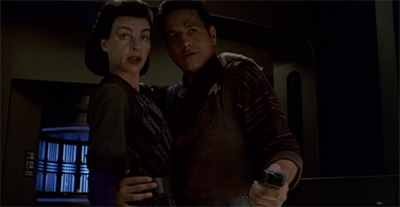
Well, hey. At least Seska’s hugely improbable attraction to Chakotay remains consistent.
Even looking beyond Seska, Voyager arguably has the most hazily-defined ensemble of the three twenty-fourth century Star Trek shows. Janeway’s personality is notorious fickle, prone to pivot on the whim of a plot. Tuvok is a stock Vulcan. Harry Kim never evolves past the factory settings of “young” , “inexperienced” and “insecure.” The decision in the third season to tone down the more stereotypical New Age Native American characterisation of Chakotay was a good decision. However, the writing staff never bothered to develop anything in its stead.
In fact, the militant and mutinous holo! Chakotay presented in Worst Case Scenario does not seem like a jarring contrast to the regular version of the character. Three seasons into the show, almost half-way to the end, Chakotay is still so hazily defined that it is entirely possible that he might be motivated by the logic that the ends could justify the means. Tellingly, the real Chakotay objects more vocally to his plot function than to his characterisation. “I don’t care what kind of story it is, as long as I’m not the bad guy this time,” he reflects on the possibility of a follow-up.
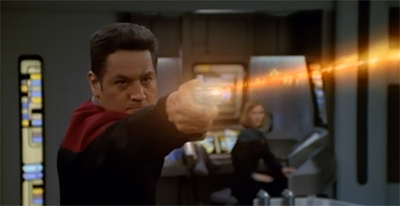
Well, to be fair, holo! Chakotay is a lot more exciting.
Even allowing for all of this, the characterisation of Seska in Worst Case Scenario makes no sense. Once the holonovel begins spiralling out of control, Torres discovers that Seska made the changes “about a month before she left the ship.” To be clear, these are changes that are designed to murder the Chief of Security in the most ridiculously showy manner possible. As soon as Tuvok trips that particular trap, everybody on the ship knows what is happening. The bridge lights up, and the crew are locked out.
Seska did not plan to abandon Voyager in State of Flux . In fact, her original plan seemed to be to remain on the ship while passing technology to the Kazon in return for support. Seska only defected to the Kazon when her treachery was discovered. With all of that in mind, why would Seska do something like this? Murdering Tuvok would most likely lead to her exposure, particularly given the way that holo! Seska brags so brazenly and ridiculously about it. It is fun to imagine what might have happened had Tuvok walked into the trap while Seska was still on board.
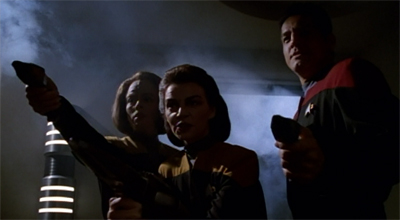
She certainly knows how to make an entrance.
After all, there is some suggestion that Seska was willing to do serious damage to the ship as part of her revenge upon Tuvok. She rigs the holographic ship to self-destruct, which in turn sets the holodeck to explode. “I don’t know how she rigged it, Captain,” Torres reports, “but when she ordered the self-destruct it initiated an overload in the holodeck power relays. The whole grid is going to blow.” What the hell is the point of all of this? Why would Seska do such a thing?
According to Worst Case Scenario , Seska is motivated by the treatment of the Maquis in the holonovel, feeling betrayed by Tuvok’s suggestion that they are inherently untrustworthy or mutinous. It is an understandable sentiment. Tuvok even alludes to it in the briefing, warning his fellow officers, “The programme has the potential to incite animosity among the crew and must be permanently deleted.” It is surprising that Chakotay is so relaxed about his portrayal in the programme, given that Tuvok betrayed him to the Federation.
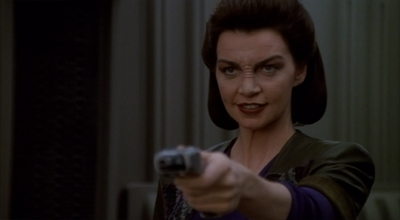
Maq-ing the Maquis.
Seska makes this argument when she confronts Paris and Tuvok. “I would have thought all that time you spent spying on us might have given you a little more insight into the Maquis,” she teases, “but after looking over what you’ve already written, I can see you need a little help.” It is not the most elegant motivation, but it works reasonably well in isolation. Except, of course, that Seska was never a true believer in the Maquis. Seska was a Cardassian spy sent to infiltrate Chakotay’s cell, to betray him to her government.
Worst Case Scenario draws Seska in the broadest possible terms. In fact, she seems to be the antagonist of the episode because she is the closest thing that Voyager has to an iconic antagonistic figure. It does not matter that her motivations do not really fit the needs or demands of the plot. Seska can be shoehorned into the role of baddie because she fits that archetypal template. Seska was never a particularly nuanced or complicated character, but Worst Case Scenario is invested in the most two-dimensional version imaginable.
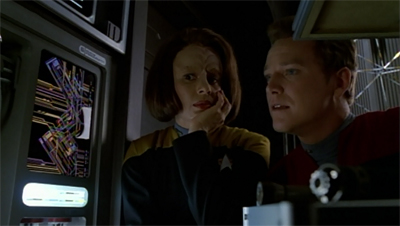
“Well, the image buffering is working, but the personality still can’t be rendered in three dimensions.”
Indeed, there’s a sense that the episode just really needs the audience to go along with it. Martha Hackett embraced the ridiculousness of her resurrection :
“I thought it was great that she thought ahead and planned something that would mess with people even after she wasn’t around,” Hackett said of the episode “Worst Case Scenario,” which resurrected her character in her original Bajoran guise. “There could have been more of that all along, every time there was a problem on the ship – ‘Oh, there she goes again!'”
Seska is very much a round peg being forced into a square hole. Her motivations are inessential. Worst Case Scenario needs an antagonist. Seska is an antagonist. So, she fills the role. It does not matter how awkwardly.
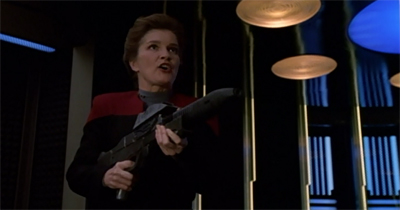
Janeway or the highway.
Then again, it feels very much like this might be the point of the exercise. About midway though Worst Case Scenario , Tuvok and Paris have a conversation about story construction. Discussing his plans for the next story beat, Paris suggests, “Well, I was thinking, Paris and Janeway retake the ship, and then she decides to execute all the conspirators.” Tuvok balks at the idea. “That is an entirely implausible plot development. Captain Janeway would never behave in such an inhumane manner.” It is a statement that seems hilarious after Equinox, Part II .
Still, assuming that this observation is true of Janeway’s character at this moment, Paris does not buy that as a reason not to tell the story. “This isn’t real life, Tuvok,” he insists. “It’s fiction.” Naturally, Tuvok disagrees. “Logic is an integral part of narrative structure,” he states. “According to the Dictates of Poetics by T’hain of Vulcan, a character’s actions must flow inexorably from his or her established traits.” Paris counters, “Well, I don’t know anything about T’hain, but I do know what makes an interesting story, and that’s unexpected plot twists.”
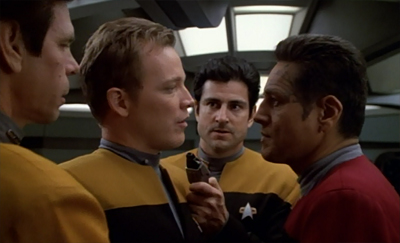
Actually, more like Chakotay or the highway…
It feels like a conversation that has taken place inside the writers’ room on Voyager on several occasions. In each case, it seems like the writers have aligned with Paris more than Tuvok. In fact, the second half of Worst Case Scenario repeatedly mocks Tuvok for his storytelling affectations. When Neelix objects to his characterisation, Paris taunts, “Tuvok, did you forget to follow the Dictates of Poetics?” Once holo! Seska starts hunting them, Paris quips, “So, Tuvok, anything in the Dictates of Poetics about how to escape from a ship full of insane holograms?”
It goes without saying that Paris and Tuvok represent a false dichotomy. It is entirely possible for a plot twist to catch the audience by surprise and be entirely true to character. Christopher Nolan films are frequently built around such developments, which serve to enrich the narratives on returning to them. Even within Deep Space Nine , there are a number of big twists that are entirely in keeping with character motivation. Garak’s torture of Odo in The Die is Cast . Dukat’s betrayal of the Alpha Quadrant in By Inferno’s Light . Odo’s betrayal of Rom in Behind the Lines .
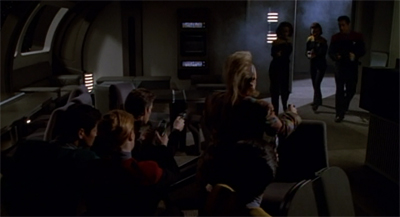
Taking his (Nee)lix…
Worst Case Scenario frequently feels like a commentary on how the writing staff approach writing for Voyager . The production team seem to align much more closely with Paris than with Tuvok. When Tuvok suggests mapping out an arc of where the story might possibly go, Paris rejects the idea out of hand. “I told you, Tuvok. I’m just making it up as I go,” he insists. “We cannot proceed without a carefully constructed outline,” Tuvok counters. However, the climax of the episode quickly devolves into a series of panicked rewrites racing towards an ending.
As with so many other Voyager episodes, Paris and Tuvok are repeatedly assisted by contrivance and convenience: an extinguisher appearing exactly when needed, a perfectly-timed alien attack, a weapons locker stacked with goodies. It recalls the techno-babble-driven solutions to other episodes like Favourite Son or Displaced . Sitting around a mess hall table at the end of the episode, in what might be the show’s most self-aware moment, Janeway toasts, “Who says deus ex machina is an outdated literary device?” It’s surprising there is not a literal reset button.
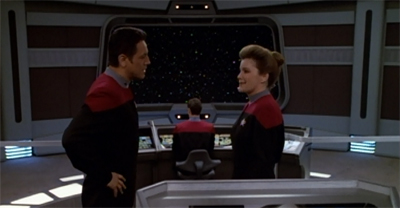
All (re)set.
To be fair, Tuvok eventually defeats holo! Seska by using weaponised irony and deploying a well-timed Chekov’s Gun. After holo! Seska murders holo! Janeway by sabotaging a phaser rifle, Tuvok boomerangs the trick back around on her. “Seska’s not the only one who knows how to cause a phaser malfunction,” he observes. It is a smarter (and more earned) ending than most Voyager episodes. However, the story still leans on the contrivance that defeating holo! Seska ends the story. (It seems more likely she would have rigged the holodeck to blow in that event.)
To be fair, Worst Case Scenario makes very clever use of the holodeck. Too frequently, the holodeck is treated as an excuse to have the cast play dress-up for a week while the writers get to play with the imagery and iconography of other genres. The best holodeck stories use the science-fiction concept to play with bigger ideas, like artificial intelligence in Elementary, Dear Data or the nature of reality in Ship in a Bottle . It is refreshing to see the Star Trek stand-by used as a commentary on storytelling.
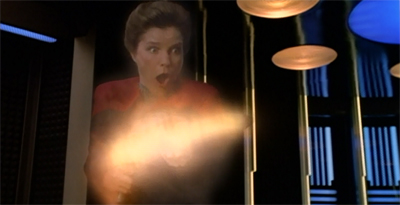
Talk about a hot ending.
As Zoë Sofoulis argues in Smart Spaces @ The Final Frontier , the episode makes great use of the holodeck as a metaphor for storytelling:
The meta-televisuality of the holodeck was brought out particularly acutely in an episode titled Worst Case Scenario near the end of Star Trek: Voyager’s third season, where the crew get involved in playing, then rescripting, an unfinished holonovel of a mutiny on Voyager featuring all the regular crew and secretly written by the security officer Tuvok as a training exercise. In support of the crew’s involvement in this diversion Captain janeway makes a speech about the importance of entertainment, culture and the arts, which resonates directly with the viewer’s own experience of watching Star Trek as entertainment. Various versions of the mutiny scenario are played out, and characters comment and criticise the way their scripts have been written, much as real actors would do with actual Star Trek scripts. Then the scenario turns dangerous once Tuvok gets in to finish the story, because the maquis saboteur Seska has completed the scenario in a way that puts the safety protocols off-line and threatens to kill Tuvok and Paris who is assisting him. “Who says deus ex machina is outmoded?” Janeway remarks, as she frantically scrambles to rewrite Seska’s narrative and script helpful events and tools into the story to save the two members of the crew.
In fact, at one point in the episode, Janeway and Torres are shown to be watching the drama play out on a small monitor that resembles a television screen.
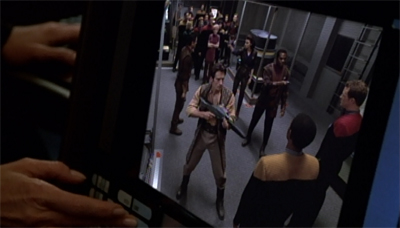
How will Tom and Tuvok get out of this one?
Of course, the holodeck is not a perfect metaphor for television storytelling. In some ways, it seems better suited as a metaphor for more emersive narratives like video games. Indeed, there are several moments in Worst Case Scenario that seem to allude to the stylistic sensibilities of video games. There is a branching structure to the narrative, as evidenced by the differences in the story experienced by Paris and Torres. There are heavily-scripted dialogue and plot exposition scenes between the action. There is instructional text directing the player to the armoury to stock up.
Worst Case Scenario consciously alludes to these ideas. The characters talk about resetting the narrative to play out alternate scenarios. “I’ve decided to take B’Elanna’s advice and replay the holonovel, this time as a full-fledged member of Chakotay’s team of mutineers,” Paris reflects. “I hope it turns out better than before.” In the messhall, Neelix offers, “Chakotay caught me, phasered me, and the programme reset. Next time, I’m going to pretend to go along with the conspirators and then stage a counterstrike.”
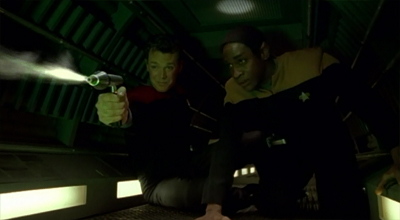
All fired up.
The episode is structured to be repetitive, as Torres and Paris play through the same basic premise in different ways. There is the suggestion of loops and narrative choke-points, as if there are certain hardcoded storybeats that cannot be prevented by the player. There is even a fleeting suggestion of the amorality of this emersive storytelling. After all, Worst Case Scenario plays through a mutiny scenario – a scenario that runs largely counter to the franchise’s utopian philosophy.
In discussing their approach to the game, Paris and Torres debate the relative merits of siding with the mutineers. In what could possibly be read as a character-based decisions, Torres hesitates before siding with Chakotay while Paris makes a big show of being a rebel before aligning himself with Janeway. In fact, Tuvok even aligns the holographic version of Paris with Janeway, suggesting that the former jailbird is actually a boy scout in disguise. However, the crew also understand that these decisions are in theory value-neutral, having no consequences outside the game.
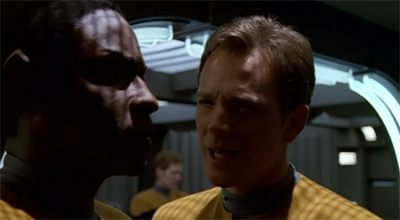
Paris is a little yellow this time around.
“You should have tried going along with the mutiny from the beginning,” Torres urges Tom. “It’s much more fun.” It should be noted that Worst Case Scenario was released in the mid-nineties, around the time that violence in video games was coming to public attention. The Entertainment Software Rating Board had been formed by the industry in 1994 as an attempt to pre-emptively block external regulation . The video game Phantasmagoria had generated no shortage of controversy on its release in 1995 . Mortal Kombat was a lightning rod of controversy .
Things were about to get even more heated. Following the school shootings at Columbine and Heath High Schools later in the decade, the morality of video games would become a heated and controversial subject . Jack Thompson would file lawsuits trying to hold video game companies responsible for the actions committed by teenagers who had played their products . The release of the Grand Theft Auto video game series would open up a new front in the culture war . As such, the dispassionate approach that Voyager adopts to these moral choices is quite compelling.
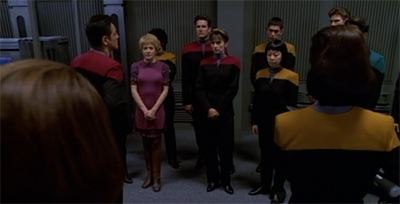
Press “Ctrl + F” for Grand Theft Starship.
It is important not to overstate how eager Worst Case Scenario is to embrace (or even explore) the amoral world of video gaming. This is not Westworld , after all. There seems to be an unspoken assumption that the only “proper” ending to the adventure has Janeway retaking the ship; Tuvok’s first draft ends with her return while Paris’ first thought is to have Janeway assume command and brutally punish her opponents. Still, the script’s willingness to accept that the moral choices in a video game are part of the fun feels progressive in the context of the nineties.
Still, while there are elements of Worst Case Scenario that play as broad commentary on the nature of video games, the episode feels very much like an exploration of the writing style on Voyager . In some respects, the episode is at once a critique and a defence of the way that the production team have approached the show in its first three seasons. Indeed, the entire basis of the holonovel is an exploration of the squandered promise of Voyager ‘s basic premise, the tension that existed between the Starfleet and Maquis crew.
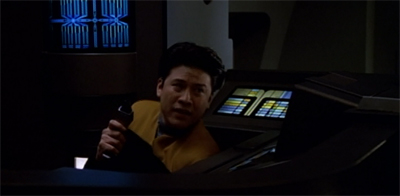
Little Kim.
In fact, Tuvok claims to have been inspired by the possibility of this sort of tension on the ship. “When you first invited the Maquis to join our crew, I believed that mutiny was a very real possibility,” Tuvok explains to Janeway. “With that in mind, I began to write a training programme for junior security officers to prepare them for such an eventuality.” Indeed, there were a number of early first season episodes that dealt with that tension; Parallax and Prime Factors both flirted with the possibility.
However, Voyager very quickly integrated its two crews and smoothed down the rough edges. Tuvok did not even get time to finish his story. “As the two crews began to work together, I concluded that the threat of an insurrection was increasingly unlikely,” he acknowledges. Given that Tuvok last accessed the file before Seska sabotaged it about a month before her departure in State of Flux , it seems likely that Tuvok reached that conclusion less than half-way through the first season. That feels about right.
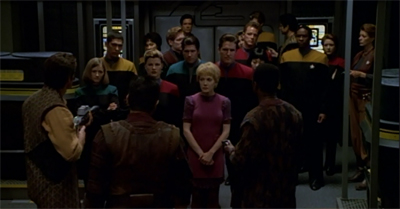
Holding the crew to Ransom.
holo! Chakotay criticises the direction of Voyager . He promises, “You’ll be part of a crew that’s going to do whatever it takes to get us home as fast as possible. Under my command, we won’t let almighty Federation principles get in the way of opportunities the way Janeway did when she destroyed the array that could have gotten us home. And we won’t be wasting precious time stopping to investigate every insignificant anomaly that we come across. What we will do is use any means necessary to acquire technology that can shorten our journey.”
These are all very valid charges against the creative decisions made early in Voyager ‘s run. holo! Chakotay points out that there was never any debate about compromise or pragmatism when it comes to the ship’s situation. holo! Chakotay even draws attention to the series’ over-reliance on the stock “anomaly of the week” shows and the lack of emphasis on the basic premise of the series. Voyager is a show that never feels like it actually explored its core premise or its raw potential. holo! Chakotay takes the creators to task for this.
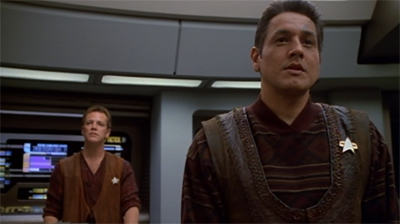
Chakotay is A-Okay!
Robert Beltran would be proud . The irony is that the rebellious and assertive version of Chakotay presented in Worst Case Scenario is much more compelling than the stock character who spurs exposition every other week. Beltran does not have the same raw charisma and charm that Jonathan Frakes used to stretch Riker beyond his two-dimensional origins, but he can play the cheeky and feckless rogue presented in Worst Case Scenario . The episode demonstrates that Chakotay’s biggest problem lies with the character’s direction more than the actor.
Indeed, Worst Case Scenario even seems to tease out the tense relationship that existed between the writers and the cast on the show. When Tuvok and Paris agree to write the ending to the holonovel, they find themselves beset by suggestions from their crewmates. Neelix is particularly self-centred. “He would never betray the Captain the way he does in that story,” Neelix insists. “No offence, Mister Vulcan, but I don’t think you understand my character very well.” Later, he proposes a new story “about a daring trader who becomes a cook on a starship.”
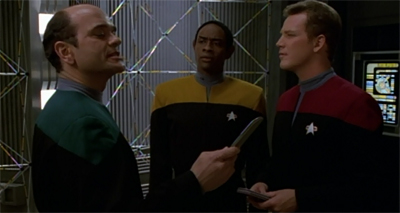
Author, Author.
This obviously reflects the awkward dialogue that would unfold between the creative staff and the performers working on the series. Robert Beltran has not pulled any punches in condemning the writers for various decisions they have made . Garrett Wang has been similarly blunt in his assessment of his relationship with the powers that be . Even Kate Mulgrew had a very strong and visceral reaction to the decision to add Seven of Nine to the cast at the start of the fourth season . There is a sense that the dynamic on Voyager could be quite tense.
However, as much as Worst Case Scenario is a criticism of Voyager or an exploration of various tensions, it is ultimately also a vindication for the writers’ approach to the show. Ultimately, Paris is proven correct. Logic and internal consistency are revealed to be secondary to the demands of the plot. Lazy writing is justified by necessity. In fact, Janeway is forced to re-write the programme coming down to a literal deadline, perhaps capturing the experience (and the inelegance) of writing for television.
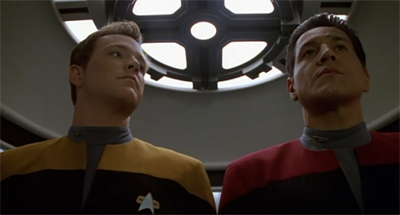
Bringing Voyager low.
In some ways, Worst Case Scenario feels almost like a celebration of fan fiction. It is an episode in which the lead characters seem excited at being coopted and reimagined through the lens of what Torres describes as a “what if” , or what comic book fans might call an “elseworld” , or what genre fans would consider an “alternate universe.” Far from being outraged that some stranger has written a story using their likenesses and character traits, the senior staff seem to endorse the possibility.
“I’m more than just a Captain,” Janeway states in defence of holonovel. “I’m the leader of a community, and communities need entertainment, culture, creative outlets. Since we’re not exactly privy to every new piece of music or holonovel that’s written back home, I think it’s only natural that we should start creating our own.” It reads almost as a defence of the way that certain writer appropriate characters in the public domain or through fan fiction, using them to give voices to perspectives or communities often overlooked; like female or LGBT fans .
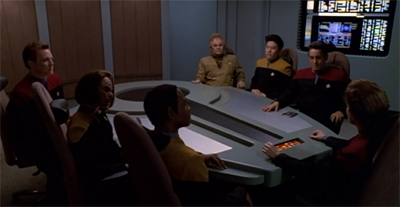
“Okay. You can write it Tom. But no slash.”
It should also be noted that the use of the holonovel within Worst Case Scenario solidifies a trend within Voyager . Much like Distant Origin , there is a sense that Worst Case Scenario hints at a motif that will soon become recurring. In Distant Origin , it was the idea of the story told from a perspective outside of the primary characters. In Worst Case Scenario , it is the concept of a story featuring copies or duplicates or doppelgangers of the original cast. Indeed, these two types of stories would occasionally overlap, as in Living Witness or Course: Oblivion .
The holonovel in Worst Case Scenario features holographic counterparts of the primary cast, copies of our regular characters that arguably play a much larger role in the story than any of the “flesh and blood” lead characters except for Tom Paris himself. Over its seven year run, Voyager becomes increasingly fixated with copies and replicas and interpretations of the lead characters. It frequently seems like the universe is populated with imitations and photocopies of the crew, to the point that it is hard to know what the “real” crew actually is.
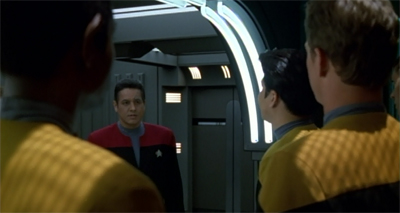
The hard cell.
Deadlock was very much ground zero for that narrative trend. That second season episode featured two versions of the eponymous ship staffed by two identical crews, culminating in two versions of Janeway going head-to-head. However, the Voyager crew would spawn historical replicas in Living Witness , a cloned ship in Demon , con artist impersonators in Live Fast and Prosper , theatrical tributes in Muse , and holonovel characters in Author, Author . This is without getting into time-displaced copies, like the future! Janeway in Endgame .
While Deep Space Nine would visit the mirror universe roughly once a year, the show’s sense of time and reality never seemed quite as fragile as that on Voyager . In many ways, Voyager was a show rooted in the nineties zeitgeist, and part of that seemed to be a recurring anxiety about the nature of its existence. Voyager suggested that reality was a malleable construct, prone to distortion or manipulation in episodes as diverse as Projections , Year of Hell, Part I , Year of Hell, Part II and Latent Image .
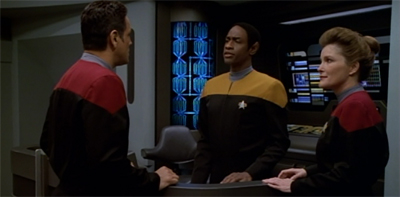
Tuvok and roll.
Film and television were fixated upon this idea of a mediated and distorted reality. The Matrix is very much the poster child for this nineties fascination, but Randy Laist puts it in a broader cultural context :
Even though each of these cyberpunk narratives establishes its own mythology of how reality is structured, taken as a whole, the proliferation of these films suggests an increasing cultural inquiry into the phenomenological issues associated with a new kind of mediated reality. Another cinematic trend within which we can position The Matrix is that of ironic meta-movies, movies that self-consciously incorporate their status as pop-cultural products into their own thematic and narrative structure, such as The Brady Bunch Movie and its sequel, A Very Brady Sequel, Scream and its sequels, the Pierce Brosnan instalments of the James Bond franchise — GoldenEye, Tomorrow Never Dies, The World Is Not Enough, Die Another Day — and South Park: Bigger, Longer, and Uncut. The defining feature of this subgenre is that the films’ characters inhabit a reality that has the ontological status of a television show or film. These films reflect a situation similar to that depicted in Pleasantville and The Truman Show, in which human reality has become “televisualised”, depleted of the existential and humanist values associated with the classical understanding of reality and reorganised according to the values of mass-media culture. Encompassing both the cyberpunk films and the meta-movies is a wider cultural-cinematic trend of films that engage in one way or another with the Baudrillardian theme of the implosion of reality and representation. Seminal films of “the long 1990s”, such as JFK, Terminator 2: Judgment Day, True Lies , The Player, Jurassic Park, Natural Born Killers, Forrest Gump, Pulp Fiction, Face/Off, Fight Club, and Being John Malkovich, all engage with the problems and possibilities associated with the new style of reality that emerges following the collapse of the Cold War and the advent of simulacral technologies such as cloning, virtual reality and digitisation. Considered from within the context of these prevailing trends, The Matrix clearly holds a privileged place in the canon of 1990s hyperreality cinema.
Episodes like Distant Origin suggest that Voyager is fascinated with the idea of storytelling. Worst Case Scenario takes that idea one step further and suggests Voyager is fascinated with the idea of its own storytelling.
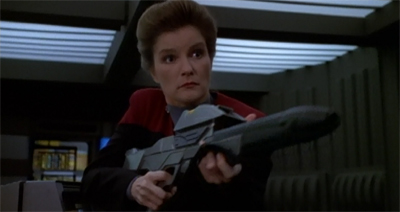
“I have some very strong feelings about Janeway’s direction as a character.”
In fact, it is worth comparing Worst Case Scenario to Our Man Bashir . Both are holodeck episodes that consciously play with the idea of storytelling. Indeed, Worst Case Scenario even borrows several cues from Our Man Bashir . It casts the ensemble in supporting roles as holodeck characters. It even has characters interrupt one another during their private time on the holodeck. “Are you in the habit of just walking in on people’s private holodeck time?” Torres demands. Paris responds, “We had a lunch date, remember?” Very Bashir, and very Garak.
However, both holodeck episodes speak to the perspective of the individual shows. Our Man Bashir is very much an episode about subverting the genre clichés and the expectations of this sort of story, much like Deep Space Nine was willing to subvert the expectations of a Star Trek series. In contrast, Worst Case Scenario is a collection of energetic plot developments thrown together with little regard for logic and with a fair convenient “deus ex machina” , much like the average episode of Voyager .
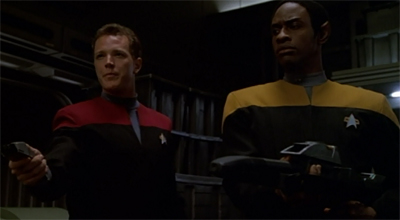
Deus without end.
To be fair, Worst Case Scenario has a lot going for it even beyond these cheeky postmodern reflections. In an interview with Cinefantastique , Kenneth Biller acknowledged that the episode was a lot of fun to write:
I won’t say it’s an out-and-out comedy. It ultimately has some serious jeopardy to a couple of the characters, but it’s a comic musing on the creative process. It operates on a lot of different levels. It’s a little inside stuff about the creation of the show, the process of writing for Star Trek, and the interaction between the actors who we write for, and the writing staff. It was a lot of fun to write.
That sense of fun and adventure shines through in Worst Case Scenario , particularly when contrasted with something as soul-numbingly dull as Displaced . It seems like a forty-five minute episode that was fun to air.
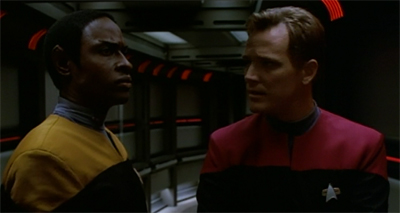
The write stuff.
There is a playfulness to the teleplay. Most notably, the episode waits until the end of the first act to confirm that it is actually a holonovel, although most astute observers will have figured it out by that point. Much like the decision to keep the first act of Distant Origin away from the title starship, Worst Case Scenario ‘s willingness to wait so long before hitting the words “computer, freeze programme” speaks to an endearing confidence. Voyager spends far too much time compromising for its audience with scripts like Macrocosm or Darkling . This confidence is reassuring.
In fact, the first act of Worst Case Scenario is genuinely brilliant. Without providing clumsy exposition or voiceover, there is a slowly building sense of “wrongness.” There is a weird feeling of discontinuity to the dialogue and the action, based on what the audience knows of the crew at this point in the run. Why isn’t Torres wearing her rank insignia? How could this possibly be considered Chakotay’s first time in command? Why are Maquis tensions suddenly an issue now? Why is Seska there? Why did Seska refer to Torres as a “Starfleet” crewmember?
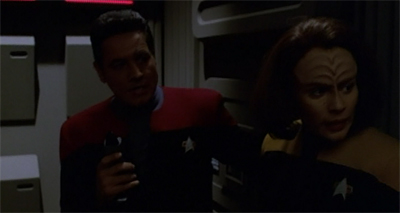
Hard to pin down.
Is this an alternate universe? Are the crew being affected by a strange interstellar phenomenon? For anybody paying any real attention “holodeck episode” quickly becomes the only possibility, and Worst Case Scenario confirms that theory at just the right moment. These little elements might seem frustrating if stretched over a single episode. However, it comes just late enough for the audience to feel smart for figuring it out, and just early enough that the plot can continue from that starting premise.
Even when the climax of the episode devolves into a silly little run-around, the script moves quickly enough that it is never boring. More than that, director Alexander Singer keeps the plot ticking over. Even when the holonovel’s introductory sequence plays on repeat for Paris, Singer finds a variety of new angles and tweaks the action just enough that it never becomes dull or lifeless. It is a credit to all involved that Worst Case Scenario flows so smoothly. Voyager has messed up the execution of much simpler story ideas in episodes like Rise .
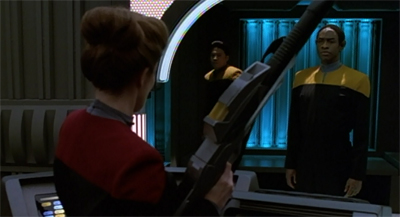
Breaking out of the box.
Worst Case Scenario suffers from a lack of sense or coherence, which is appropriate for an episode offering a commentary on the production of Voyager . At the same time, it is energetic enough (and fun enough) that it can get past these limitations, which feels like it captures the best possible interpretation of Voyager .
You might be interested in our other reviews from the third season of Star Trek: Voyager :
- Basics, Part II
- False Profits
- Sacred Ground
- Future’s End, Part I
- Future’s End, Part II
- The Q and the Grey
- Blood Fever
- Favourite Son
- Before and After
- Distant Origin
- Worst Case Scenario
- Scorpion, Part I
Share this:
Filed under: Voyager |
8 Responses
Martha Hackett is great. I know the character was underwritten, but she milks every scene with her great facial expressions. See her crocodile grin when she says the holodeck has “been sealed”.
I never laugh watching the show, largely because the characters are as funny as a tumor. But the mere thought of Neelix coming at you (with a flaming hot iron) makes me chuckle every time. Tom was amusing in this episodes, too. The holodeck episodes always see him at his best.
I don’t know. I kinda laughed at Tuvok murdering Neelix in Meld.
But then, that might just be me.
Martha Hacket was not too pleased with the way Seska was killed off at the start of the season, so she returns at the end of it in what seems like an attempt by the writers to redress the balance. I have to say that Worst Case Scenario is a much more satisfying swan song for Seska and it certainly was for Hacket. You can see how much fun she’s having as she gets to do her departure from the show all over again and this time gets it right (she also suits the new hairdo much better than her S1 do).
Although WCS is not really intended to be more than a bit of late season filler, it emerges as one of S3’s better episodes. Seska’s not a bland antagonist like the Nyrians (who must rank as one of Trek’s most anonymous villains) and Martha Hacket gleefully chews on the scenery as she gets to stage her own takeover of Voyager (how many times has that happened this year?), even if it’s just a holographic one. I liked all of the little S1 touches and changes in perspective to the program as it feels like a nostalgic throwback to Voyager’s early years before the sweeping changes of S4.
Seska’s trap buried within the narrative is really the equivalent of an Easter Egg (I kept expecting something else to happen if I stayed through the end credits), which we’ve seen in similar episodes like Ship in a Bottle, Civil Defense, Babel and Badda-Bing, Badda-Bang. And Tom and Tuvok’s adventures on the Holodeck are as fun as they’re shared adventure in Future’s End. Yeah, Worst Case Scenario may be just trying to clear away some of the clutter before season’s end, so it’s ironic its one of S3’s more wholly enjoyable episodes.
Yep. It’s not particularly brilliant, but it’s fun. And that sense of fun carries the episode surprisingly far.
As much as I tend to love Voyager at its goofiest, it proved to be too far of a stretch for me to accept the idea that most of the crew, much less their captain, would be anything but apprehensive with people on the ship living out a detailed fantasy where the Maquis and Starfleet crew members ended up in a shooting war with each other over a conflict that was only a few years old and still very fresh in most crew members’ minds.
Sure, the show abandoned the series-long conflict that might have grown out of its split-crew concept, and while that decision squandered one of the biggest points of interest available to it at the premiere, it’s possible to accept that, within the fictional world of the series, nearly everyone aboard circled the wagons real quick in mutual defense of the ship.
But… just a few short years later, still trapped decades of travel away from everyone and everything they knew, that the Maquis crew would want to be reminded that the ship’s security officer betrayed all of them, then planned their defeat as mutineers by running his officers through a violent and graphic simulation of the same? That’s… kind of insane. That they’d want to play out the simulation themselves or that the captain would agree to that, is COMPLETELY nuts. In any believable plot, it would generate animosity, resentment and distrust that simply could not be ignored or reversed without serious consequences to the friendships among the main characters, at least within that single episode.
Imagine if you found out the security guards at your job had secretly identified you as a potential threat to be put down with lethal force based on your past associations, and had started creating a simulation training themselves to do so that included your name and likeness! How comfortable would you be working at that job in the future? Would you trust those security guards to look out for YOUR safety any further than you could throw them? Assuming your boss wanted people to get along at work, do you think they’d encourage people to play that simulation for fun? Now imagine your workplace is a million miles from nowhere, everyone’s there by accident and no one has the option of going home…
This seems like an episode that mutated from a mediocre pitch to a downright sleep-deprived-punchy, off-the-rails end result. That it was filmed and shown on TV suggests those behind this particular episode not only had little idea how to manage the show they were running, they also either had an extremely poor grasp of how people work (see above) or (more likely) they were utterly uninterested in making the characters in any way believable and not yet able to strike the sitcom-like tone they needed to make THAT work.
That’s all very fair. However, I think that it’s a larger issue with Voyager rather than a problem with this individual episode. At the very least, Worst Case Scenario is true to what Voyager is. It’s far ( faaaaaaar ) from a perfect episode, particularly when the last act turns into generic nonsense. However, it’s also fun and interesting for a lot of its runtime, which is more than can be said for a lot of Voyager episodes.
I’ve been going back and watching Voyager, guided in part by your reviews here, and that seems an accurate assessment!
Ha! Glad to be a (hopefully worthy) companion piece!
Leave a comment Cancel reply
This site uses Akismet to reduce spam. Learn how your comment data is processed .
Recent Posts
- 378. Gojira Mainasu Wan (Godzilla Minus One) (#—)
- 377. I’ll Always Know What You Did Last Summer (#—)
- 376. Wall-E – Ani-May 2024 (#59)
- Doctor Who: The Devil’s Chord (Review)
- Doctor Who: Space Babies (Review)
Recently tweeted…
- "I Simply Am Not There": The Existential Horror of Eighties Excess in "American Psycho"...
- Doctor Who: The Devil's Chord (Review)
- Doctor Who: Pyramids of Mars (Review)
- Star Trek: The Original Series (Reviews)
- The Time Traveler's French Mistress...
Available at…

Blogs Well Worth Your Time
- 1001 Must See Films
- Andrew at the Movies
- Anomalous Material
- Cut the Crap Movie Reviews
- Encore Entertainment
- Fandango Groovers
- FlixChatter
- Four of Them
- It Rains… You get Wet…
- Jameson Cult Film Blog
- Jar Watches Films
- Let's Go To The Movies
- M. Carter at the Movies
- Marshall and the Movies
- Movie News First
- Musings from a Man Lost in La Mancha
- Never Mind Pop Film
- Paragraph Film Reviews
- Roger Ebert's Journal
- Ross v. Ross
- Scannain.com
- Screenwriter (Donald Clarke, Irish Times)
- Strange Culture
- The Film Cynics
- The Pompous Film Snob
- The Projection Booth
- Things That Don't Suck
- Too Busy Thinking About My Comics
- Undy a Hundy
Film Nerd Resources
- CinemaBlend (News)
- Internet Movie Database
- Rope of Silicon
- The Guardian Film Blog
- James Berardinelli
- Roger Ebert
Email Subscription
Enter your email address to follow this blog and receive notifications of new posts by email.
Email Address:
Sign me up!
Blog at WordPress.com. WP Designer.
- Already have a WordPress.com account? Log in now.
- Subscribe Subscribed
- Copy shortlink
- Report this content
- View post in Reader
- Manage subscriptions
- Collapse this bar
Worst Case Scenario Stardate: 50971.5 Original Airdate: May 7, 1997
<Back to the episode listing
Star Trek ® is copyright of CBS Studios Inc . Copyright © 1966, Present. The Star Trek web pages on this site are for educational and entertainment purposes only. All other copyrights property of their respective holders.

- Web Channels
- Star Trek: Voyager
Worst Case Scenario

Members of the Voyager crew clandestinely participate in a hidden holodeck program where the ship's Maquis members stage an insurrection.

Martha Hackett
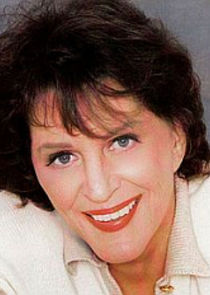
Majel Barrett Roddenberry
Cast appearances.
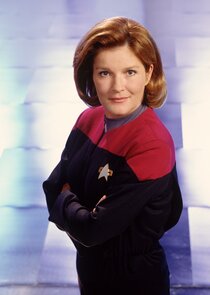
Kate Mulgrew
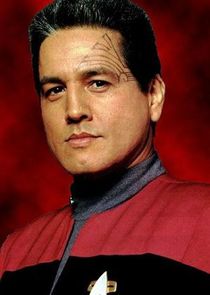
Robert Beltran
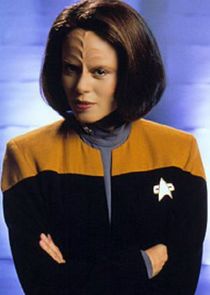
Roxann Dawson
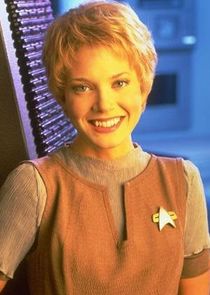
Jennifer Lien
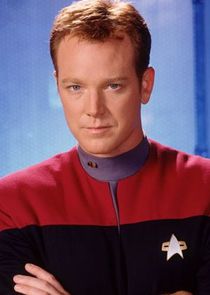
Robert Duncan McNeill

Ethan Phillips
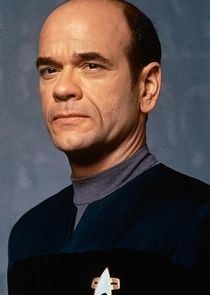
Robert Picardo
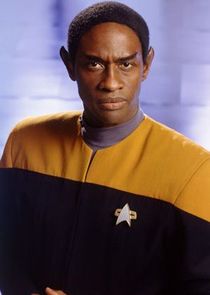
Garrett Wang
Episode discussion.
No comments yet. Be the first!
- Show Spoilers
- Night Vision
- Sticky Header
- Highlight Links

Follow TV Tropes
http://tvtropes.org/pmwiki/pmwiki.php/Recap/StarTrekVoyagerS3E24WorstCaseScenario

Star Trek Voyager S 3 E 24 "Worst Case Scenario" » Recap

B'Elanna Torres discovers a holodeck program on Voyager simulating a Maquis rebellion where Commander Chakotay calls for a mutiny after Janeway leaves the ship on an away mission. This program soon becomes popular as the crew try it out for themselves, either taking the side of the mutineers or Janeway loyalists trying to retake Voyager from the Maquis.
While Paris is trying the program, he discovers that the program is unfinished, leaving everyone wondering who created it in the first place. Tuvok admits to being the program's creator, having designed it as a training simulation in case the members of the Maquis actually attempted a mutiny, but not completing it when he saw how the members of Starfleet and the Maquis were getting along with each other .
This episode provides examples of:
- Aborted Arc : This episode lampshades how the cultural conflict between the Maquis and Starfleet personnel that was established in the show's first few episodes was quickly abandoned and has been virtually ignored for the better part of three seasons. The premise of the episode allows the writers to temporarily revive it in a holodeck setting.
- All There in the Manual : A short story released in one of the compilations after the show had ended details both when Tuvok decided to stop writing the program Insurrection Alpha , why he did so, and that he had only completed what he estimated to be about 25% of it.
- And You Thought It Was a Game : Tuvok admits he wrote the program as a tactical simulation , not a holo-novel. Seska's rewrite shifts the program into Hunting the Most Dangerous Game .
- Anti-Villain : Holo-Chakotay. Yes, he's the bad guy for committing mutiny, but he's committed to executing a non-violent mutiny, is willing to recruit anyone who is willing to join him, and offers extra provisions to those who will get left off the ship. His mission statement for returning home is also pretty reasonable: take every opportunity to get home faster without worrying about scientific discovery along the way.
- Backwards-Firing Gun : Happens twice — first to Holo-Janeway, then Holo-Seska.
- Badass Boast Holo-Janeway: You've just threatened the wrong woman, Chakotay.
- Breather Episode : Although it becomes a Crisis of the Week plot in the second half, the Leaning on the Fourth Wall comedy does allow a lighter moment before "Scorpion".
- To Season One.
- After helping to save the day, Janeway suggests doing a western as their next holo-program. Now there's an idea...
- The program's version of Seska is an In-Universe example. The Maquis all obey her even though Chakotay is supposed to be their leader, Chakotay is madly in love with her, and her plans are so perfect that the heroes only manage to defeat her by hacking various Deus Ex Machinas into the program. Given that the real Seska was the one who rewrote the program and that, like most Cardassians, she has a very high opinion of herself, this was pretty much inevitable.
- Neelix says the next holonovel should be about a daring trader who becomes a cook on a starship.
- Virtually everyone tries to pressure Tuvok into turning their characters into this in the rewrite, leading to as much frustration as he's allowed by being a proper Vulcan.
- As benefits an episode about the writing process, it's a literal gun. Tuvok uses Seska's Backwards-Firing Gun trick to kill her.
- The mutiny is launched while Holo-Janeway has left the ship to meet with an alien race called the Rukani. The real Janeway uses them to pull a Deus ex Machina .
- The Chessmaster : Seska created the booby-trapped program a month before she left Voyager, and it's gone active over a year after she died .
- Chick Flick : Tuvok doesn't like B'Elanna's suggestion they add a little 'passion' to the novel. Seska does the honors of chick-ifying the story a bit by having her holographic self and holo-Chakotay fall in love with each other in the rewrite.
- Chronic Backstabbing Disorder : Holo-Neelix quickly changes sides to the mutineers, a development the real Neelix takes offense to. In fairness to Tuvok, the program would have been written not long after "Caretaker", when Neelix abused their trust so he could rescue Kes.
- Cliffhanger : Tuvok created an accidental one when he stopped writing the program.
- Several clues cue hardcore fans that the teaser is taking place earlier in Voyager's continuity. In the opening scene, B'Elanna is wearing a Starfleet ensign's pip, and Chakotay is speaking openly of how "the Maquis" aren't getting along with Tuvok and Janeway, along with stating they're still seventy years from the Alpha Quadrant (he also never once calls her by name, only 'Ensign'). Janeway and Kes are wearing their original hairstyles, and Jonas is called on the comm even though he was killed back in Season 2 (albeit clearly not being voiced by Raphael Sbarge). The wham moment is Seska's appearance after her death in "Basics, Part II".
- Seska's motive for revenge on Tuvok is that he was a Federation undercover agent who betrayed them, which fits with the fact that she was still posing as a member of the Maquis at the time.
- Crazy-Prepared : Not only did Seska's reprogramming seal the holodeck and disable the safety protocols, but it also deactivated the transporter rooms and comms. There are also boobytraps to destroy the power grid if the crew attempts to pull the plug and the reprogramming can adapt to whatever changes Janeway and Torres attempt to make.
- Creative Differences : In-Universe between Tom and Tuvok.
- Dead Fic : To everyone's frustration. Tuvok is ordered to finish it, despite Insurrection Alpha never having been a holonovel in the first place.
- Deadly Doctor : Holo-EMH "treats" Tom's phaser burn by injecting him with nitric acid, No Sells his attempt to attack him when he's choking Tuvok and then tosses both of them out of the Sick Bay with one arm. "A little proverbial salt in the wound."
- Death Is Cheap : Seska shows that a minor thing like death doesn't stop her from being the Villain of the Week . And Janeway dies again, this time as a holodeck character.
- Depending on the Writer : The holoprogram has four different authors, each with a different purpose.
- Designated Villain : Invoked in-universe. Chakotay jokingly observes that he was made the bad guy in the holo-novel and hopes the next one is different.
- Deus ex Machina : Janeway rewrites the program to have an alien ship come to their aid, giving Tuvok time to snag a phaser rifle. At the end of the episode, the characters are sitting around, talking about the program and Tuvok compliments Janeway on this move. " Who says deus ex machina is an outdated literary device? " she responds.
- Diabolus ex Machina : Seska's program adapts to any ploy by those trapped inside it.
- Digital Avatar : Seska, for her deceased actual self in her revised version of Tuvok's program. Tom Paris comments that Seska wouldn't let a little thing like death stop her from getting even with Tuvok.
- Everything Is Trying to Kill You : Seska is quite the sadist.
- In-universe, Janeway's insistence that the Holo-novel be completed over the wishes of the original author could be seen as a bit of this.
- Another in-universe example occurs after Paris insists he'll work alone. Tuvok reminds him that only he has the authorization to make changes to the program.
- Fake Action Prologue : Chakotay's mutiny, which Tom walks in on to set up the Proscenium Reveal .
- Fake-Out Opening : The opening scenes are presented in such a way that makes it appear as if B'Elanna is trapped in an Alternate Universe or that there's some other sort of Mind Screw at work. Everything and everyone except for her is just off somehow and B'Elanna acts confused by her surroundings, and that's before Seska unexpectedly turns up seemingly alive and well. It's not until The Reveal when Tom breaks in (when he's supposed to be off the ship with Janeway) that the real plot is revealed, and that B'Elanna is just following along with the program.
- Torres is complaining that the holonovel doesn't have any romance. Paris: I could add a steamy love scene between the Starfleet conn officer and the Maquis engineer . Torres: Oh, that's realistic!
- Tom's interest in writing a holonovel eventually leads to the Show Within a Show The Adventures of Captain Proton , a program that emphasizes fun and action over characterization , as per his arguments with Tuvok.
- There are a few hints about the episode opening with a Fake Action Prologue (e.g. Torres being referred to as an ensign and never by name, Jonas still being alive, Tuvok saying Chakotay is still new to being first officer, Janeway's hair in the power bun that preceded "Future's End", etc.).
- The first time Paris plays the holo-novel, he tries to thwart the mutiny and gets thrown in the brig. After the holographic Tuvok stresses the importance of biding their time and following proper procedure and states that it may take up to a week for a good opportunity to break out to present itself, a bored Paris asks who wrote this holo-novel.
- Fake Defector : One of the options in the program, taken by Paris and Neelix. B'Elanna says it's more fun to join the rebellion .
- Freudian Excuse : Torres (a former member of the Maquis) joins the mutiny immediately. Paris (a guy with a problematic history on both sides) initially tries to stop the mutiny the first time he plays and then switches sides when it's convenient for him.
- Good Is Boring : B'Elanna advises Tom to go join the mutiny from the beginning, as it's more fun. Tom agrees when he finds Tuvok's plan for foiling the mutiny is to do nothing till next week's episode.
- Halfway Plot Switch : A comical story turns dangerous due to Seska's tampering with the holo-novel. Also applies in-universe, as decisions of those playing the ensign in the game can vastly affect the course of the story.
- Heel–Face Revolving Door : Invoked by Tom as a way to test the progam's limits. He begins the program assuring Holo-Chakotay that he'll side with the mutineers, but once it actually begins, tries to save Tuvok. Then when Holo-Chakotay makes his offer to the captured crew, Tom steps forward to join him. He later notes to B'Elanna that this sequence of events made Holo-Chakotay so suspicious of him that he would only allow Tom to do minor maintenence work.
- Hilarious Outtakes : A scene where Tim Russ hams up being shot, and Robert Beltran flubs his line. Look for it on Youtube. Paris: It's Paris and Janeway. Holo-Chakotay: (long pause) How do you know? (general laughter)
- Holodeck Malfunction : Justified by deliberate sabotage.
- Hypocrite : Seska wants revenge on Tuvok for betraying the Maquis, when she herself is a Cardassian infiltrator.
- After Paris tells Tuvok that he's going to have Janeway execute the mutineers, Tuvok complains that this is against Janeway's established personality and that characters should not deviate so tremendously. Neelix walks over and insists that he would never betray the captain like he did in the holonovel. Paris makes fun of Tuvok over this point.
- And the Holo-EMH throttling Tuvok; "You're looking well."
- Killer Game Master
- Klingon Promotion : When holo-Chakotay argues against killing Tom and Tuvok (as Janeway reprograms him to), holo-Seska shoots him.
- Laser-Guided Karma : The program was set to become a Deadly Game the next time Tuvok logged in. He does so with Tom Paris, the other crewmember who betrayed the Maquis crew to the Federation.
- Tuvoks reasons for abandoning the simulation boil down to "the show's writers dropped the Maquis plot without really doing anything with it".
- Chakotay says that the mutineers' new mission will not waste time by investigating every random anomaly the ship passes, reflecting a common criticism of the show's concept.
- Load-Bearing Boss : The program shuts down when Holo-Seska is killed.
- Mexican Standoff : Several. One memorable shot is Paris doing this with his holographic counterpart and the program shutting down afterwards.
- Mirror Match : Having taken the side of the mutineers, Tom is startled to be pointing a phaser at himself as a Janeway loyalist. Then the program shuts down .
- Most Writers Are Writers : A lot of the dialogue resembles a writers' room argument over how to write a Star Trek: Voyager episode.
- Muse Abuse : Averted as everyone finds Insurrection Alpha rather amusing, even Chakotay who's the villain of the program. Neelix is the only one who takes offense, and that doesn't stop him from playing it.
- The Mutiny : Though played out as a training simulation.
- Mutual Kill : Holo-Janeway and Holo-Chakotay stun each other.
- Mythology Gag : Janeway thinks the next holonovel should be a Western. Janeway's preferred holonovel was originally going to involve herself as a Western pioneer , but was replaced with the Gothic romance novel . invoked
- New Era Speech : Holo-Chakotay gives one after seizing Voyager . Chakotay: Take a good look around you. You're under armed guard. You may also notice that your senior officers aren't here. They're in the brig. They'll be put off the ship at the first habitable planet we come to. All except Janeway and Paris, who will arrive at their rendezvous coordinates to find that Voyager 's not there. In short, I've taken control of the ship. I don't blame any of you for the mistakes of your leaders, so I'm giving you a choice. You can be put off the ship with your superiors or you can do what Neelix and some of your other crew members have already done and join me. If you do, you'll be part of a crew that's going to do whatever it takes to get us home as fast as possible. Under my command, we won't let almighty Federation principles get in the way of opportunities the way Janeway did when she destroyed the array that could have gotten us home. And we won't be wasting precious time stopping to investigate every insignificant anomaly that we come across. What we will do is use any means necessary to acquire technology that can shorten our journey. To hell with Starfleet regulations. You have fifteen minutes to make up your minds.
- New Rules as the Plot Demands : The original holonovel was built as a functional training tool and wouldn't allow the player to cheat through modifying holodeck settings, but Seska writes a new scenario where it actively manipulates the rules to ensure their eventual death. Tom and Tuvok are stuck in a situation actively working against them , and their only hope is Janeway as a Deus ex Machina rewriting the program in real time to give them a fair shot.
- No Ending : Or so Tuvok thought.
- Not Bad : What Tom says after Tuvok uses Seska's backfiring gun trick against her .
- Not Himself : The holodeck Chakotay is overly friendly yet stilted in interacting with the real characters, notably pausing to allow them to reply to his comments , an early sign that it's a holodeck program.
- The Not Secret : Word quickly spreads of Insurrection Alpha despite (or because) of its subversive nature. Which makes it puzzling that no one knows who wrote it. Paris: Remember the good old days when it was impossible to keep a secret on a ship this small?
- Off the Rails : The primary development in the second half of the episode, where any semblance of a story or training purposes are thrown out the window in an Everything Trying to Kill You mode.
- Only the Author Can Save Them Now : Invoked in-universe by Janeway, who intends to "rewrite" Seska.
- Other Stock Phrases : "You'll never get away with this." (Holo-Harry to the mutineers), "I've been waiting a long time for this." (Holo-Chakotay before he shoots Tom), and "If you want something done right, you've got to do it yourself." (Holo-Seska before she tries to kill everyone)
- Out of Character : First, Tuvok got Neelix's character completely wrong (something Neelix later objects to). Then Tom Paris wants to have Janeway execute all the mutineers. And when Seska got at the character profiles...
- Platform Hell : What Seska's programming turns the holo-novel into. Everything is designed to torture whoever's trapped and actively be unfair.
- Post-Mortem Comeback : A highly adaptive hologram of Seska enters the program and manipulates it to her own ends.
- Put Down Your Gun and Step Away
- Railroading : Seska programmed the holodeck to do this when Tuvok and Paris were on the verge of getting the upper hand.
- Reasonable Authority Figure : When everyone thinks the program is a mere holo-novel, Janeway and Chakotay are good sports about it. They want to know who wrote it out of mere curiosity. Janeway also sees the value in the crew creating their own fiction as a stress reliever, especially since they're cut off from all the newest forms of media back in the Alpha Quadrant.
- The Reveal : Everyone assumes that Insurrection Alpha is an action-adventure holonovel with some Take That! jabs at Janeway's command decisions. It turns out to be a program created by Tuvok to train his security officers against a Maquis mutiny.
- The Revolution Will Not Be Civilized : Once Seska gets a hold of the story.
- Running Gag : Once Paris volunteers to complete the program, other crewmembers keep butting in with suggestions.
- Save-Game Limits : Possibly because the program is unfinished, Torres has to reset it so that Paris can play from the start.
- Self-Fulfilling Prophecy : Invoked; when the Maquis and Starfleet crewmembers end up working well together , Tuvok realizes his program could itself create tensions between the two groups and deletes it. Or so he thinks. Tuvok's expectations are subverted when they find it and enjoy it .
- Smooch of Victory : Holo-Seska and Holo-Chakotay snog after killing Holo-Janeway. No one is impressed.
- Snark-to-Snark Combat : Tom and Tuvok arguing over the changes to the holonovel.
- Spread Shot : Seska: I wouldn't do that if I were you. This phaser's set on wide beam. I could take you all in one shot.
- Superdickery : The Teaser with Chakotay asking B'Elanna to take part in The Mutiny .
- The Tape Knew You Would Say That : Seska activates the Self-Destruct Mechanism , keyed only to her voice. Holo-Seska: If you don't hand over that phaser rifle, everyone on this ship is going to be dead in... (waits) Computer: Self-destruct in forty five seconds. (Seska grins)
- Technician vs. Performer : Ultimately why Tuvok and Paris are urged to work on the program together. Tuvok's precision and faithfulness to accuracy has resulted in a realistic scenario without strawmen or melodramatic pomp... but it's also bogged down in strict adherence to reality and can't really deviate with surprise developments. This necessitates Tom creating a more entertainment-focused moderation, as there wasn't any option for a true Face–Heel Turn . (In theory, since we never get to see the outcome of their effort.)
- Complaining about the holo-novel not having an ending, Paris says it's sadistic. Later he's put through Seska's version of Hell.
- B'Elanna rejects the idea that she might have a steamy romance with Tom as completely unrealistic. They'll officially begin a relationship just four episodes later.
- Unwanted Assistance : Everyone offering writing tips to Paris and Tuvok. Paris also treats Tuvok's offer as this, until Tuvok reveals that only he can rewrite the program.
- Vitriolic Best Buds : Tuvok and Tom.
- Welcome to Corneria : The program always starts with Chakotay approaching the player character in a corridor on the way to the turbolift and starting the same conversation.
- Who Writes This Crap?! : Paris's comment the first time he runs the program when the holographic Tuvok in the brig suggests that they might need to spend as long as a week observing their captors for weaknesses. "A week?! Who wrote this stuff?" This is a clue that he's in a training scenario, not a holodeck adventure where Rule of Drama prevails.
- Win to Exit : Once Holo-Seska gets herself killed courtesy of Tuvok's phaser sabotage, the program ends.
- With All Due Respect : Janeway to Tuvok, telling him to "loosen up".
- Worst Aid : Seska's version of the Doctor decides to treat Paris's phaser wound with 20cc's of nitric acid! Doctor: A little proverbial salt in the wound.
- Write What You Know : In-universe with Tuvok, as this was a training simulation. At the end of the episode, he notes that any future holo-novels will not be so close to home.
- Writing by the Seat of Your Pants : In-Universe —this is how Paris wants to finish the program, much to Tuvok's disapproval.
- Star Trek Voyager S 3 E 23 "Displaced"
- Recap/Star Trek: Voyager
- Star Trek: Voyager S3E25 S4E1 "Scorpion"
Important Links
- Action Adventure
- Commercials
- Crime & Punishment
- Professional Wrestling
- Speculative Fiction
- Sports Story
- Animation (Western)
- Music And Sound Effects
- Print Media
- Sequential Art
- Tabletop Games
- Applied Phlebotinum
- Characterization
- Characters As Device
- Narrative Devices
- British Telly
- The Contributors
- Creator Speak
- Derivative Works
- Laws And Formulas
- Show Business
- Split Personality
- Truth And Lies
- Truth In Television
- Fate And Prophecy
- Image Fixer
- New Articles
- Edit Reasons
- Isolated Pages
- Images List
- Recent Videos
- Crowner Activity
- Un-typed Pages
- Recent Page Type Changes
- Trope Entry
- Character Sheet
- Playing With
- Creating New Redirects
- Cross Wicking
- Tips for Editing
- Text Formatting Rules
- Handling Spoilers
- Administrivia
- Trope Repair Shop
- Image Pickin'
Advertisement:
Worst Case Scenario
A buried holonovel with high entertainment value depicting a Maquis mutiny is discovered.
In this episode of the podcast, Wes and Clay discuss “Worst Case Scenario” and episodes with end-of-season-itis. Plus! The guys chat about the bland charisma of Robert Beltran, the difference between a holo-novel and a holo-program, and forced comradery.
- Post author By Wes
- Post date 10/10/2023
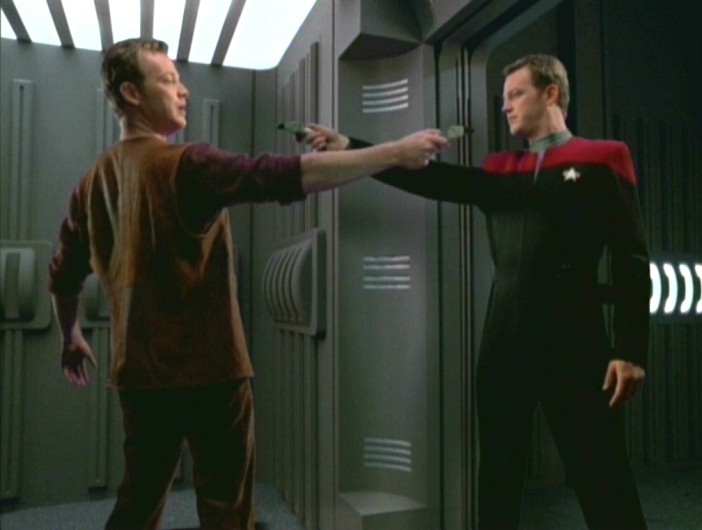
Subscribe: Apple Podcasts | Spotify | RSS | More
Greetings, Trekkers and podcast aficionados! I’m Wes, and along with my co-host Clay, I’m thrilled to welcome you to another insightful episode of “ The Pensky Podcast .” Today, we navigate through the intricate narrative layers of “Worst Case Scenario,” the 25th episode of the third season of Star Trek: Voyager, originally aired on May 14, 1997. Crafted by screenwriter Kenneth Biller and navigated under the directorial gaze of Alexander Singer, this episode stitches together a plot that is as unconventional as it is peppered with missed opportunities.
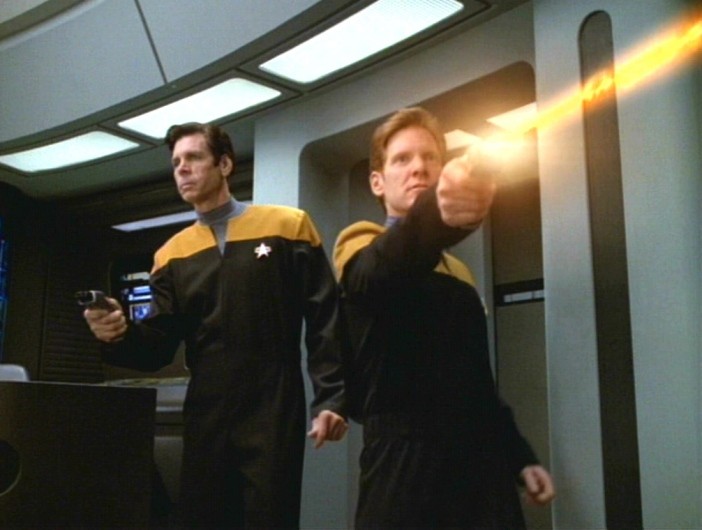
“Worst Case Scenario” lures us into a unique narrative, where the discovery of a holo-novel depicting a Maquis mutiny on Voyager sets the stage for a layered discussion about loyalty, rebellion, and the dynamics within our beloved starship crew. It’s here that Clay and I delve into a hearty discussion about the wasted narrative potential of Star Trek: Voyager as a series, considering how the foundation of complex histories and alliances among the crew could have paved the way for richer, more nuanced stories and conflicts.
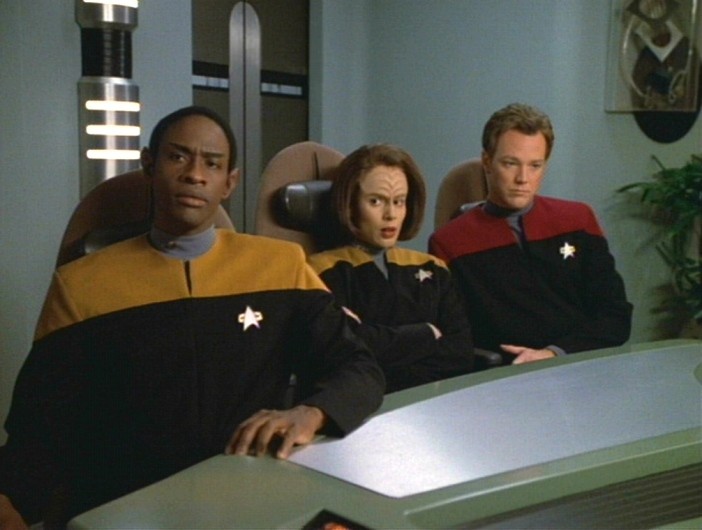
The peculiar structure and pacing of this episode don’t escape our scrutiny. We traverse the winding paths of its unusual narrative turns, addressing how its somewhat jarring transitions and evolving plot points lend a distinct, albeit somewhat disjointed, quality to the story arc. And let’s not forget Robert Beltran’s portrayal of Chakotay : while exuding a steady, reliable presence, we find ourselves mulling over his somewhat bland charisma and how it intertwines with the unfolding plot, especially in light of the mutiny setting.
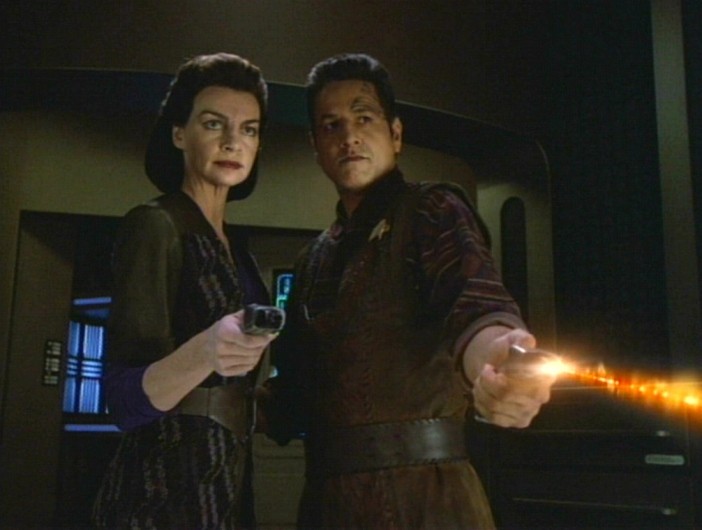
Seska’s plot for posthumous revenge via the holo-novel offers another rich vein for discussion. Her strategy, both deviously clever and, arguably, a tad on the goofy side, propels us into an exploration of character motivations, villain archetypes, and how this impacts the tension and payoff within the episode. Furthermore, we navigate through the somewhat forced camaraderie among the characters, pondering whether it serves as a cohesive glue for the crew or emerges as an incongruous element amidst the extant interpersonal dynamics.
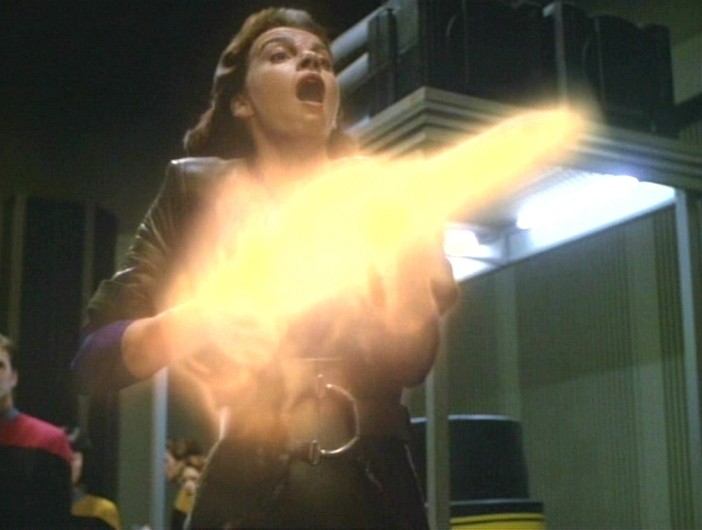
In conclusion, “The Pensky Podcast” thrives as a platform where episodes like “Worst Case Scenario” are untangled, and the threads of narrative, character, and thematic elements are laid bare for exploration. For those eager to dive deeper into the expansive universe of Star Trek, our Patreon page awaits, teeming with additional content that propels you further into the boundless cosmos of sci-fi discussion. Engage with us, and let’s explore the stars together!
Star Trek: Voyager (TV Series)
Worst case scenario (1997), full cast & crew.

Directed by
Writing credits , cast (in credits order) complete, awaiting verification , produced by , music by , cinematography by , editing by , casting by , production design by , costume design by , makeup department , second unit director or assistant director , art department , sound department , special effects by , visual effects by , stunts , camera and electrical department , casting department , costume and wardrobe department , music department , additional crew .
Release Dates | Official Sites | Company Credits | Filming & Production | Technical Specs
Contribute to This Page
- Full Cast and Crew
- Release Dates
- Official Sites
- Company Credits
- Filming & Production
- Technical Specs
- Plot Summary
- Plot Keywords
- Parents Guide
Did You Know?
- Crazy Credits
- Alternate Versions
- Connections
- Soundtracks
Photo & Video
- Photo Gallery
- Trailers and Videos
- User Reviews
- User Ratings
- External Reviews
- Metacritic Reviews
Related Items
- External Sites
Related lists from IMDb users

Recently Viewed

40 Facts About Elektrostal
Written by Lanette Mayes
Modified & Updated: 01 Jun 2024
Reviewed by Jessica Corbett

Elektrostal is a vibrant city located in the Moscow Oblast region of Russia. With a rich history, stunning architecture, and a thriving community, Elektrostal is a city that has much to offer. Whether you are a history buff, nature enthusiast, or simply curious about different cultures, Elektrostal is sure to captivate you.
This article will provide you with 40 fascinating facts about Elektrostal, giving you a better understanding of why this city is worth exploring. From its origins as an industrial hub to its modern-day charm, we will delve into the various aspects that make Elektrostal a unique and must-visit destination.
So, join us as we uncover the hidden treasures of Elektrostal and discover what makes this city a true gem in the heart of Russia.
Key Takeaways:
- Elektrostal, known as the “Motor City of Russia,” is a vibrant and growing city with a rich industrial history, offering diverse cultural experiences and a strong commitment to environmental sustainability.
- With its convenient location near Moscow, Elektrostal provides a picturesque landscape, vibrant nightlife, and a range of recreational activities, making it an ideal destination for residents and visitors alike.
Known as the “Motor City of Russia.”
Elektrostal, a city located in the Moscow Oblast region of Russia, earned the nickname “Motor City” due to its significant involvement in the automotive industry.
Home to the Elektrostal Metallurgical Plant.
Elektrostal is renowned for its metallurgical plant, which has been producing high-quality steel and alloys since its establishment in 1916.
Boasts a rich industrial heritage.
Elektrostal has a long history of industrial development, contributing to the growth and progress of the region.
Founded in 1916.
The city of Elektrostal was founded in 1916 as a result of the construction of the Elektrostal Metallurgical Plant.
Located approximately 50 kilometers east of Moscow.
Elektrostal is situated in close proximity to the Russian capital, making it easily accessible for both residents and visitors.
Known for its vibrant cultural scene.
Elektrostal is home to several cultural institutions, including museums, theaters, and art galleries that showcase the city’s rich artistic heritage.
A popular destination for nature lovers.
Surrounded by picturesque landscapes and forests, Elektrostal offers ample opportunities for outdoor activities such as hiking, camping, and birdwatching.
Hosts the annual Elektrostal City Day celebrations.
Every year, Elektrostal organizes festive events and activities to celebrate its founding, bringing together residents and visitors in a spirit of unity and joy.
Has a population of approximately 160,000 people.
Elektrostal is home to a diverse and vibrant community of around 160,000 residents, contributing to its dynamic atmosphere.
Boasts excellent education facilities.
The city is known for its well-established educational institutions, providing quality education to students of all ages.
A center for scientific research and innovation.
Elektrostal serves as an important hub for scientific research, particularly in the fields of metallurgy , materials science, and engineering.
Surrounded by picturesque lakes.
The city is blessed with numerous beautiful lakes , offering scenic views and recreational opportunities for locals and visitors alike.
Well-connected transportation system.
Elektrostal benefits from an efficient transportation network, including highways, railways, and public transportation options, ensuring convenient travel within and beyond the city.
Famous for its traditional Russian cuisine.
Food enthusiasts can indulge in authentic Russian dishes at numerous restaurants and cafes scattered throughout Elektrostal.
Home to notable architectural landmarks.
Elektrostal boasts impressive architecture, including the Church of the Transfiguration of the Lord and the Elektrostal Palace of Culture.
Offers a wide range of recreational facilities.
Residents and visitors can enjoy various recreational activities, such as sports complexes, swimming pools, and fitness centers, enhancing the overall quality of life.
Provides a high standard of healthcare.
Elektrostal is equipped with modern medical facilities, ensuring residents have access to quality healthcare services.
Home to the Elektrostal History Museum.
The Elektrostal History Museum showcases the city’s fascinating past through exhibitions and displays.
A hub for sports enthusiasts.
Elektrostal is passionate about sports, with numerous stadiums, arenas, and sports clubs offering opportunities for athletes and spectators.
Celebrates diverse cultural festivals.
Throughout the year, Elektrostal hosts a variety of cultural festivals, celebrating different ethnicities, traditions, and art forms.
Electric power played a significant role in its early development.
Elektrostal owes its name and initial growth to the establishment of electric power stations and the utilization of electricity in the industrial sector.
Boasts a thriving economy.
The city’s strong industrial base, coupled with its strategic location near Moscow, has contributed to Elektrostal’s prosperous economic status.
Houses the Elektrostal Drama Theater.
The Elektrostal Drama Theater is a cultural centerpiece, attracting theater enthusiasts from far and wide.
Popular destination for winter sports.
Elektrostal’s proximity to ski resorts and winter sport facilities makes it a favorite destination for skiing, snowboarding, and other winter activities.
Promotes environmental sustainability.
Elektrostal prioritizes environmental protection and sustainability, implementing initiatives to reduce pollution and preserve natural resources.
Home to renowned educational institutions.
Elektrostal is known for its prestigious schools and universities, offering a wide range of academic programs to students.
Committed to cultural preservation.
The city values its cultural heritage and takes active steps to preserve and promote traditional customs, crafts, and arts.
Hosts an annual International Film Festival.
The Elektrostal International Film Festival attracts filmmakers and cinema enthusiasts from around the world, showcasing a diverse range of films.
Encourages entrepreneurship and innovation.
Elektrostal supports aspiring entrepreneurs and fosters a culture of innovation, providing opportunities for startups and business development .
Offers a range of housing options.
Elektrostal provides diverse housing options, including apartments, houses, and residential complexes, catering to different lifestyles and budgets.
Home to notable sports teams.
Elektrostal is proud of its sports legacy , with several successful sports teams competing at regional and national levels.
Boasts a vibrant nightlife scene.
Residents and visitors can enjoy a lively nightlife in Elektrostal, with numerous bars, clubs, and entertainment venues.
Promotes cultural exchange and international relations.
Elektrostal actively engages in international partnerships, cultural exchanges, and diplomatic collaborations to foster global connections.
Surrounded by beautiful nature reserves.
Nearby nature reserves, such as the Barybino Forest and Luchinskoye Lake, offer opportunities for nature enthusiasts to explore and appreciate the region’s biodiversity.
Commemorates historical events.
The city pays tribute to significant historical events through memorials, monuments, and exhibitions, ensuring the preservation of collective memory.
Promotes sports and youth development.
Elektrostal invests in sports infrastructure and programs to encourage youth participation, health, and physical fitness.
Hosts annual cultural and artistic festivals.
Throughout the year, Elektrostal celebrates its cultural diversity through festivals dedicated to music, dance, art, and theater.
Provides a picturesque landscape for photography enthusiasts.
The city’s scenic beauty, architectural landmarks, and natural surroundings make it a paradise for photographers.
Connects to Moscow via a direct train line.
The convenient train connection between Elektrostal and Moscow makes commuting between the two cities effortless.
A city with a bright future.
Elektrostal continues to grow and develop, aiming to become a model city in terms of infrastructure, sustainability, and quality of life for its residents.
In conclusion, Elektrostal is a fascinating city with a rich history and a vibrant present. From its origins as a center of steel production to its modern-day status as a hub for education and industry, Elektrostal has plenty to offer both residents and visitors. With its beautiful parks, cultural attractions, and proximity to Moscow, there is no shortage of things to see and do in this dynamic city. Whether you’re interested in exploring its historical landmarks, enjoying outdoor activities, or immersing yourself in the local culture, Elektrostal has something for everyone. So, next time you find yourself in the Moscow region, don’t miss the opportunity to discover the hidden gems of Elektrostal.
Q: What is the population of Elektrostal?
A: As of the latest data, the population of Elektrostal is approximately XXXX.
Q: How far is Elektrostal from Moscow?
A: Elektrostal is located approximately XX kilometers away from Moscow.
Q: Are there any famous landmarks in Elektrostal?
A: Yes, Elektrostal is home to several notable landmarks, including XXXX and XXXX.
Q: What industries are prominent in Elektrostal?
A: Elektrostal is known for its steel production industry and is also a center for engineering and manufacturing.
Q: Are there any universities or educational institutions in Elektrostal?
A: Yes, Elektrostal is home to XXXX University and several other educational institutions.
Q: What are some popular outdoor activities in Elektrostal?
A: Elektrostal offers several outdoor activities, such as hiking, cycling, and picnicking in its beautiful parks.
Q: Is Elektrostal well-connected in terms of transportation?
A: Yes, Elektrostal has good transportation links, including trains and buses, making it easily accessible from nearby cities.
Q: Are there any annual events or festivals in Elektrostal?
A: Yes, Elektrostal hosts various events and festivals throughout the year, including XXXX and XXXX.
Elektrostal's fascinating history, vibrant culture, and promising future make it a city worth exploring. For more captivating facts about cities around the world, discover the unique characteristics that define each city . Uncover the hidden gems of Moscow Oblast through our in-depth look at Kolomna. Lastly, dive into the rich industrial heritage of Teesside, a thriving industrial center with its own story to tell.
Was this page helpful?
Our commitment to delivering trustworthy and engaging content is at the heart of what we do. Each fact on our site is contributed by real users like you, bringing a wealth of diverse insights and information. To ensure the highest standards of accuracy and reliability, our dedicated editors meticulously review each submission. This process guarantees that the facts we share are not only fascinating but also credible. Trust in our commitment to quality and authenticity as you explore and learn with us.
Share this Fact:

- Bahasa Indonesia
- Eastern Europe
- Moscow Oblast
Elektrostal
Elektrostal Localisation : Country Russia , Oblast Moscow Oblast . Available Information : Geographical coordinates , Population, Area, Altitude, Weather and Hotel . Nearby cities and villages : Noginsk , Pavlovsky Posad and Staraya Kupavna .
Information
Find all the information of Elektrostal or click on the section of your choice in the left menu.
- Update data
Elektrostal Demography
Information on the people and the population of Elektrostal.
Elektrostal Geography
Geographic Information regarding City of Elektrostal .
Elektrostal Distance
Distance (in kilometers) between Elektrostal and the biggest cities of Russia.
Elektrostal Map
Locate simply the city of Elektrostal through the card, map and satellite image of the city.
Elektrostal Nearby cities and villages
Elektrostal weather.
Weather forecast for the next coming days and current time of Elektrostal.
Elektrostal Sunrise and sunset
Find below the times of sunrise and sunset calculated 7 days to Elektrostal.
Elektrostal Hotel
Our team has selected for you a list of hotel in Elektrostal classified by value for money. Book your hotel room at the best price.
Elektrostal Nearby
Below is a list of activities and point of interest in Elektrostal and its surroundings.
Elektrostal Page

- Information /Russian-Federation--Moscow-Oblast--Elektrostal#info
- Demography /Russian-Federation--Moscow-Oblast--Elektrostal#demo
- Geography /Russian-Federation--Moscow-Oblast--Elektrostal#geo
- Distance /Russian-Federation--Moscow-Oblast--Elektrostal#dist1
- Map /Russian-Federation--Moscow-Oblast--Elektrostal#map
- Nearby cities and villages /Russian-Federation--Moscow-Oblast--Elektrostal#dist2
- Weather /Russian-Federation--Moscow-Oblast--Elektrostal#weather
- Sunrise and sunset /Russian-Federation--Moscow-Oblast--Elektrostal#sun
- Hotel /Russian-Federation--Moscow-Oblast--Elektrostal#hotel
- Nearby /Russian-Federation--Moscow-Oblast--Elektrostal#around
- Page /Russian-Federation--Moscow-Oblast--Elektrostal#page
- Terms of Use
- Copyright © 2024 DB-City - All rights reserved
- Change Ad Consent Do not sell my data
Elektrostal (Q198419)

Wiktionary (0 entries)
Multilingual sites (0 entries).
- Pages with maps
Navigation menu

COMMENTS
Star Trek: Voyager. ) " Worst Case Scenario " is the 67th episode and the 25th and penultimate episode of the third season of Star Trek: Voyager. This episode focuses on events that take place on a spacecraft virtual reality system (a Star Trek holodeck on board the USS Voyager ), involving a plot based on factions established earlier in the ...
A buried holonovel with high entertainment value depicting a Maquis mutiny is discovered. B'Elanna Torres looks apprehensive as she walks down the corridor on the ship and approaches the turbolift to report for duty, and even more so as Chakotay joins her casually. Once they are in the turbolift, Chakotay begins asking a series of strange questions pertaining to his dislike for Tuvok and ...
Worst Case Scenario: Directed by Alexander Singer. With Kate Mulgrew, Robert Beltran, Roxann Dawson, Jennifer Lien. B'Elanna's discovery of a holonovel projecting a Maquis takeover of Voyager enthralls the crew, but a hidden edit could kill its mystery author.
"Worst Case Scenario" Star Trek: Voyager 3x25. 66th out of 168 release in VOY. 471nd of 727 released in all. Original Airdate: 14 May, 1997. Stardate: 50953.4 (2373) ... but 'Voyager' has always been my fave ST. I do like this episode and I DO agree Seska was indeed a great villain - it showed because she was resurrected so many times! ...
By being more outlandish, "Worst Case Scenario" ends up, really, being all the more typical. But this is a good episode nonetheless, with some very clever scenes. The first half of the episode is superb, as we're introduced to a brewing Maquis mutiny that turns out to be a holodeck simulation written by an anonymous author.
Worst Case Scenario is a flawed episode of Star Trek: Voyager.It is also breathtakingly ambitious. There is a strong argument to be made that Worst Case Scenario is the strongest Star Trek script ever written by Kenneth Biller. It is a story about storytelling, using the holodeck as a jumping off point for all sorts of self-reflective commentary on the sort of creative compromises necessary to ...
CHAKOTAY: And when the shooting starts, I'm going to need to know which side you're on. JANEWAY: Well, Commander, Voyager's all yours. CHAKOTAY: There's a first time for everything, I guess. Don't worry, Captain, I'll keep your ship safe and sound. JANEWAY: I'm sure you will.
B'Elanna's discovery of a holonovel projecting a Maquis takeover of Voyager enthralls the crew, but a hidden edit could kill its mystery author. Members of the Voyager crew furtively participate in a hidden holodeck programme where the ship's Maquis members stage an insurrection. When words gets out, Tuvok and Paris get trapped within the ...
Episode Guide for Star Trek: Voyager 3x25: Worst Case Scenario. Episode summary, trailer and screencaps; guest stars and main cast list; and more.
Worst Case Scenario By Michelle Erica Green Posted at January 13, 2004 - 2:36 PM GMT ... "Worst Case Scenario" pointed out all sorts of plot threads which Voyager let drop instead of pursuing ...
At the end of the episode, he notes that any future holo-novels will not be so close to home. Writing by the Seat of Your Pants: In-Universe —this is how Paris wants to finish the program, much to Tuvok's disapproval. A page for describing Recap: Star Trek Voyager S 3 E 24 "Worst Case Scenario". B'Elanna Torres discovers a holodeck program on ...
Celebrating the 25th Anniversary of Star Trek: Voyager, this is one of 50 episode reviews of the 4th live-action series in the Star Trek franchise.Tweet us @...
"Worst Case Scenario" is markedly different. This Voyager episode involves a holo-novel that simulates a mutiny by the Maquis elements of the Voyager crew. (Minor spoiler: it is revealed that Tuvok wrote the program shortly after the Maquis crewmen were integrated, as he feared such an event might happen and wanted to train for the possibility.)
Today, we navigate through the intricate narrative layers of "Worst Case Scenario," the 25th episode of the third season of Star Trek: Voyager, originally aired on May 14, 1997. Crafted by screenwriter Kenneth Biller and navigated under the directorial gaze of Alexander Singer, this episode stitches together a plot that is as unconventional ...
"Star Trek: Voyager" Worst Case Scenario (TV Episode 1997) cast and crew credits, including actors, actresses, directors, writers and more. Menu. Movies. Release Calendar Top 250 Movies Most Popular Movies Browse Movies by Genre Top Box Office Showtimes & Tickets Movie News India Movie Spotlight.
S3 E25: Worst Case Scenario. Sign up for Paramount+ to stream. TRY IT FREE. 46M MAY 14, 1997 TV-PG. S3 E25: A holo-novel is discovered in the computer banks, in which Chakotay raises a Maquis mutiny on Voyager. Then, when Paris and Tuvok discover that the program has been altered, they and the Voyager crew must race to stay one step ahead of a ...
Worst Case Scenario. With Garrett Wang and Robert Duncan McNeill. The Delta Flyers is a weekly Star Trek: Voyager rewatch and recap podcast hosted by Garrett Wang and Robert Duncan McNeill. Each week Garrett and Robert will rewatch an episode of Voyager starting at the very beginning. This week's episode is Worst Case Scenario.
This is the best stereotypical Holodeck episode in all of Star Trek, IMO. Great story and great execution, I flipped my shit when Tuvok confessed to writing it.
40 Facts About Elektrostal. Elektrostal is a vibrant city located in the Moscow Oblast region of Russia. With a rich history, stunning architecture, and a thriving community, Elektrostal is a city that has much to offer. Whether you are a history buff, nature enthusiast, or simply curious about different cultures, Elektrostal is sure to ...
Elektrostal is a city in Moscow Oblast, Russia, located 58 kilometers east of Moscow. Elektrostal has about 158,000 residents. Mapcarta, the open map.
A pretty good episode, but the turbo lift ride from the bridge to deck two took an eternity. It took exactly as long as it needed to to finish the dialogue lol. Indeed. It made me laugh. I'm still watching the episode. It's almost a trek tradition. The exact same thing happens in TOS in The Enterprise Incident.
Elektrostal Geography. Geographic Information regarding City of Elektrostal. Elektrostal Geographical coordinates. Latitude: 55.8, Longitude: 38.45. 55° 48′ 0″ North, 38° 27′ 0″ East. Elektrostal Area. 4,951 hectares. 49.51 km² (19.12 sq mi) Elektrostal Altitude.
city in Moscow Oblast, Russia